What are you guys Think about this video que opinan de este video
Yo i need his cock
Ya no me aguanto viendo una verga tan bella asi y no puedo cogerlo o mamarle para que venga en mi boca. Que rabio me da
Hey, everyone! It’s been quite a while since I last posted here. This is Sara, XSEED’s PC localization programmer! I’ve been buried shoulder-deep in my work on Zwei: The Ilvard Insurrection recently, but I’m here today to talk to you about something for the Trails in the Sky games. What? Those games have been out a pretty long time now? I know! I just can’t seem to stop supporting them! Send help.
Jokes aside, here’s the deal. With the recent release of Trails of Cold Steel on PC with help from the awesome Durante, I’ve been hit by some strokes of inspiration of my own. Have you read his guest blogs? Go read his guest blogs! I’ll wait.
Okay. With that out of the way, I’ve got two things to discuss here that I’ve been working on for the Trails in the Sky games, and the cool thing is that you can try both of these things out right now on Steam!
- Turbo Mode -
If you’ve been following Durante’s blogs, you’ll already know the general idea of what Turbo Mode is. In Trails of Cold Steel, this is a function you can use to speed up the game by customizable factors just by holding down a button, automatically skipping most battle animations as well. You can even configure field speed and battle speed individually. Knowing that fantastic Cold Steel’s PC release might bring a lot of new players into the series, and thus, into the Sky games, I felt that adding this feature to the Sky games would improve the overall consistency of experience and help these players feel right at home.
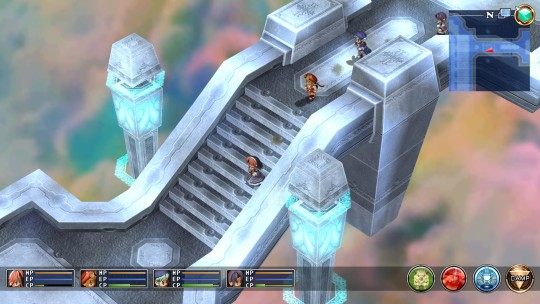
This feature is available for testing right now on Steam! It isn’t quite feature-complete yet, though, as it doesn’t skip animations, and there are a couple of minor bugs. The bugs I’m aware of right now are that turboing in the field may occasionally cause you to clip through objects. Please use care when turboing outside of battle. Turboing in battle may sometimes result in some very minor animation errors, too. In the future, most of these animations will be skipped, and I’ll do my best to fix the clipping problem. In the meanwhile, please be sure to report any issues you may have with the feature to our support e-mail at [email protected]!
For those of you who are playing versions of the game from other storefronts, don’t despair; I haven’t forgotten about you! I just want to make sure this new feature is in as good of shape as possible before I do a full official release!
That’s about it for Turbo Mode, so that brings me to the other thing that I’ve been working on…
- DirectX9 Version -
The Trails in the Sky series was originally coded exclusively for DirectX8. I always thought that was a bit odd, since other Falcom games of the era were given the DirectX9 treatment, or even released with both versions supported. “What’s that mean, though?” I hear you guys asking. That’s okay, I can’t blame you! You probably know that DirectX is a graphics API used popularly in Windows games, but at this point, version 8 has gotten pretty old. So old, in fact, that some vendors have stopped supporting it fully – most notably, Nvidia has long since removed full support for it on certain systems, especially laptops utilizing Nvidia Optimus technology. Those are basically laptops with built-in Nvidia graphics cards that also have Intel integrated cards included for less-intensive uses.
Well, people have been having trouble with Trails in the Sky on their Nvidia Optimus rigs for a while now, and I’ve always been a bit sad that I couldn’t help them out very much until now. I had been writing a DirectX9 version of the engine for a while, as DX9 is still well-supported and resembles DX8 fairly closely. Unfortunately, in the process, I ran into a lot of stumbling blocks that resulted in the process being harder than I’d imagined; it led me to understand why Falcom hadn’t bothered, either. As great as their code was, it just wasn’t made with DX9 in mind originally. In the past week, I finally overcame these stumbling blocks, though, and am pleased to announce a public beta of the DirectX9 version of the Trails in the Sky games on Steam! If you own the games on Steam, you’ve already got the beta now!

I’m basically looking to improve these versions and make them function as well as the original DirectX8 versions did before I put them into a wider release. So far, it seems like it’s working out pretty well! There have been a couple noticeable bugs – mostly strange blocky objects that appear rarely, especially beds for some weird reason – but given some time, I’m pretty sure it’ll all get ironed out. That means better performance ahead for pretty much everyone, especially Nvidia Optimus users! Further into the future, it will also lead to better graphics options that make the games look even better, so please look forward to it. You can help me out right now by testing out the new beta versions on Steam and leaving feedback on any problems you might find!
While I’ve got you here, though, is there anything else? Well, maybe just a little, yeah…
- Other Stuff in the Sky -
I always try to make it a point to support the games I work on as much as possible, no matter how old those games get. Along with these two features, I’ve made some small tweaks to the engine to adjust its performance here and there, and I added the long-missing “Monster Guide Button” that really should have been there all along. My bad on not getting to that one sooner! As time moves along, I’d like to improve these games even more, and hopefully continue to live up to the high bar of quality that people are learning to expect from us. I’d like to make better configuration tools, closer to the one Cold Steel has now, with even more options to help these games shine. For the time being, though, I’m going to keep fixing as many bugs as I can, such as the recently fixed New Game+ bugs in Trails in the Sky the 3rd. All of this and more will come to those of you playing from GOG and the Humble Store as well. Just let them have a little more time cooking in the oven. I promise it’ll be worth it.
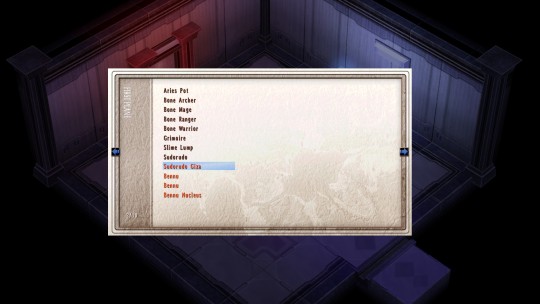
I’d like to thank all of you fans for being there and giving so much support. Thank you to Durante as well, for inspiring me to do something you guys will enjoy so much. I am forever blessed to have the chance to work on these wonderful games that I dearly love. Until next time!
Sara J. Leen
Localization Programmer, XSEED Games
The launch of Trails of Cold Steel on PC is here, which means it’s high time for the third and final iteration of this 3-part series of articles. The first part dealt with lifting the performance of the game to a level that I consider acceptable – great, even. The second one explained all the graphical options beyond the console version which were implemented in this port.
In this post I’ll introduce two final, previously unrevealed features which will be included in the release. The first should make everyone who has a lot of games to play and only little time – or wants to re-play Trails of Cold Steel on PC without any tedium – happy, while the second one is only really relevant for a much smaller audience – but I’m sure they will be enthusiastic about it.
Turbo Mode
The first feature is “Turbo Mode”. If this functionality is enabled in the launcher, holding down the R2 button (or other controller equivalent, or whatever you mapped it to in keyboard/mouse controls) will speed up battles, cutscenes and even field progress by a factor of four. This allows you to very quickly complete “unimportant” battles or traverse some of the larger late-game maps. When Turbo mode is active, it’s indicated by an animated on-screen icon:

While this is not entirely new - a few PC ports over the years have included a similar feature - it is fully integrated and has one particularity which I call “Smart Turbo”. In Trails of Cold Steel, when you “unbalance” an enemy, you are given a short timed prompt to select a special “link” move. During this prompt, even if you keep Turbo Mode active, it will automatically stop speeding up the progress of time so that you have the same chance to select an action that you have while playing normally.
During battle, turbo mode also skips most animations in addition to the general speed-up function. You can see the impact of this mode on a battle in this Youtube video.
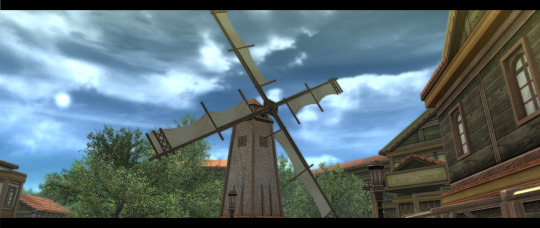
Ultrawide Aspect Ratio Support
I was talking about a surprise feature that I didn’t believe XSEED would go for in my previous post, and this is it. Supporting additional aspect ratios in a game as UI-heavy as a JRPG, and one that was only ever targeted at 16:9, is never trivial, so my time estimate for this included several full work days. Since time is, in a very real sense, money in this case, I didn’t expect that XSEED would go for implementing a feature which – as of the latest Steam survey – is only really useful for less than 2% of the potential players.
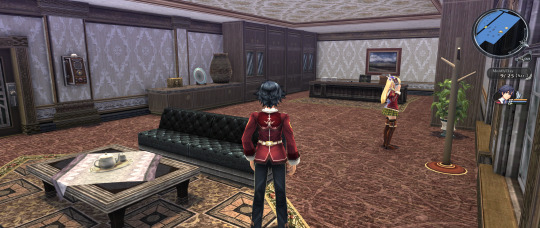
Well, they did go for it, and after working through 32 distinct issues the game now supports any aspect ration larger than 16:9 out of the box! Of course, there are some limitations: primarily, that the main menu remains at 16:9, and also some battle UI overlays don’t transition perfectly at the edges of the 16:9 frame. But for most situations, I implemented unique solutions that I think look pretty nice.

Of course, if I was going to do wide aspect ratio support, I wasn’t going to do it just for 21:9 – every aspect ratio larger than 16:9 should work, at least in theory. So if, say, you have a 3-monitor 48:9 setup, then that will look a bit like this:

I have to admit that, just because of the constraints of reality, the ultrawide option is not tested as rigorously as playing at 16:9, so it’s not unlikely that you might find a small graphical hiccup in one particular scenario in the game or another. If you do, please report it.
Conclusion
Whew. A long road is about to come to its end, and I fervently hope that the game will work as well for you as it does on our testing machines. It’s the first time a game is released where I have been largely responsible for most of its PC-specific code, so I’m a bit nervous, but I do believe that it’s in a much better state than many of the releases I had a look at over the past few years.
And what I know is that if something major does go wrong, I won’t wait months, weeks, or even days to communicate with whoever is affected and try to get it resolved.
Welcome to the second part of this 3-part series on the PC port of Trails of Cold Steel. The first part dealt with lifting the performance of the game to a level that I consider acceptable – great even. Of course, you might now be wondering what to do with all that performance headroom if you’re planning to play on something faster than a GPD Win. After all, there isn’t really any need to run a turn-based JRPG at 300 FPS or more.
In this article I’ll introduce the various graphical settings I’ve added to the game, going into a bit more detail on some of them. I’ve been looking forward to this one in particular, so I hope you enjoy reading it as much as I did writing it.
The Launcher
Let’s start with a look at the game’s launcher:

There are a few things I’d like to remark on:
- Every single option has a description text, and often it also shows visual comparisons of the settings (on the right)
- The entire launcher you see here can be navigated just using a gamepad (actually, I made a tool for this that allows natural 2D-navigation and changing options in arbitrary C# WinForms dialogs using Xinput, and XSEED has graciously agreed to allow me to open source it, so look for that on my blog when things are less hectic)
- Can you spot the typo on this screenshot? It’s fixed by now.
The rest of this article will look at the options contained in the “Display”, “Image Quality”, “Shading” and “Graphics” sections of the launcher in order.
Display
Here, you have the basic choice between windowed or fullscreen rendering with or without v-sync. In terms of framerate, there are 3 settings: a 30 FPS limit, a 60 FPS limit, and unlimited FPS. While the game was 30 FPS on consoles, in the PC version both 30 and 60 are fully supported. Unlimited variable FPS also work very well in all my testing, but are not fully QA’d throughout the game and offered on a “your own risk” basis.
Finally, I’ve also added an option for adjusting the Field of View (FoV). While not as important as in first-person games, playing close to a large monitor often makes a larger Field of View desirable. Here you see a comparison between the default FoV (left) and a very high setting (I wouldn’t personally choose one this high, it’s just for illustration):
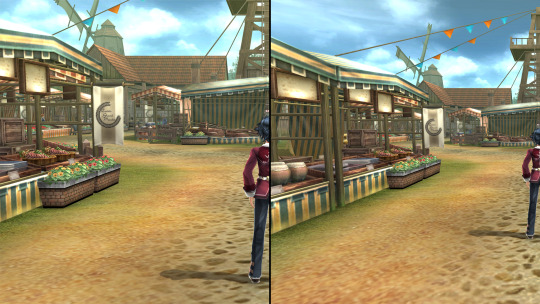
Image Quality
This section deals with resolution, anti-aliasing (AA) and texture filtering. Resolution works as you would expect. In terms of anti-aliasing, MSAA 2x, 4x and 8x are supported, and transparency supersampling (TrSSAA) is there as a high-end option to improve the quality of alpha-tested surfaces. It was strange to discover that TrSSAA is actually significantly more difficult to implement in DX11 than it is in Direct3D 9 or OpenGL, but at least that explains why so few games offer it. Here is a comparison to show what each option does – of course, the difference is much more pronounced in motion:

Before we move on to shading, there’s one thing I need to get off my chest. You know what really annoys me? When games offer some AA option, but do not apply that AA solution consistently to everything in the game (like e.g. character models in menus.) I had to extend the underlying engine to do it, but rest assured that when you select an AA option in Trails of Cold Steel on PC, everything will get that level of AA:
- The main game rendering will be AA’d of course.
- The rendered character dialogue portraits will also get the AA.
- The character models shown on the equip screen? AA’d.
- Character busts during special events? AA’d.
- Yes, even the minimap rendering gets MSAA. And TrSSA. Because why not!
Oh, and there’s an anisotropic filtering option. It’s just a checkbox, because honestly, there’s no reason to bother with less than 16xAF for this game. Even the GPD Win can do it!
Shading
Now this is where things get even more interesting. There are four options related to the quality of dynamic shadows:
- Shadow Resolution, which, as you’d expect, adjusts the resolution of the shadow maps all the way from “low” to “absurd”.

- Shadow Casters, changing which objects cast shadows. Shadows are often enabled only selectively for performance reasons, with artists manually selecting which objects and characters are sufficiently “important” to cast shadows. This setting overrides that selection and makes every object in the scene cast a shadow.
- Shadow Distance, which can increase the distance shadows are cast at. Ever annoyed by shadows appearing and disappearing a few meters in front of you? I know I am. Well, not on my watch.
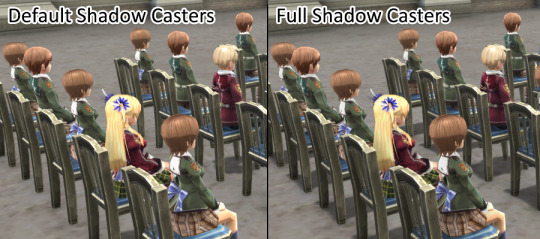
- Finally,Shadow Filtering enables softer and more aesthetically pleasing shadow transitions.
Even with these improved real-time shadows, the game’s environments still looked a bit flat. Since the environments, unlike the characters’ cel shading, are rendered and shaded in a more realistic style, I thought that a more realistic modern technique, namely ambient occlusion, might look good. With some engine improvements I was able to integrateHBAO+, one of the highest-quality and best-performing AO solutions available:
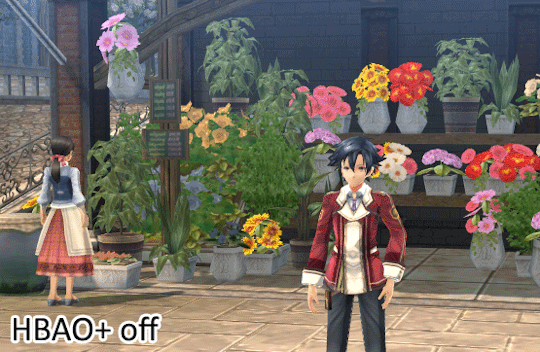
As you can see, it lends everything a lot more depth and plasticity, and also makes objects in the shadows appear more grounded.
Graphics
Last, but certainly not least, the “Graphics” options seem comparatively unexciting with just two checkboxes: and really, the High Quality Depth of Field setting just does what it says on the tin and while it’s a nice improvement, it’s nothing to write home about.
On the other hand, the Unlimited Draw Distance option is, and excuse me if I say so myself, a really big deal. In fact, doing something about the draw distance was one of the very first requests that came up when the first article was posted. What I’ve done about it is completely eliminate any form of pop-in, by making all objects and characters draw at any range. On some maps this is quite a significant extra CPU load, especially combined with full shadow casters, but nothing a modern Desktop PC can’t easily deal with.
Since pop-in is hard to demonstrate in images, I’ve made a video that really shows off the considerable effect of this option.
Other Improvements and Conclusion
In addition to these options, there are a few graphical improvements over the console version that are “always on” and don’t have a launcher option. For example, the glow effects are rendered at 4 times the fidelity, and uncompressed textures are used instead of the compressed assets designed for consoles wherever they were available.
I hope you’ll enjoy these graphical improvements as much as I enjoyed creating them and writing about them. In the final article, we’ll have a look at some non-graphical features, and one particular, somewhat programming-intensive graphical option that will make a few people really happy and which I never expected XSEED to go for. Till then!
SENRAN KAGURA Peach Beach Splash is the fifth SK game I’ve worked on as a localizer, the sixth to hit North American shores, and marks the fifth anniversary of the series as a whole. As the guy whose job it is to bring out the characters’ voices, working on a long-running series like this one makes me think about how to keep those voices fresh and interesting from game to game.
By now, the main characters’ quirks and personalities are all well established. Katsuragi likes boobs, Ryōna likes pain, Asuka and Homura like fighting each other, and so on. Knowing the girls’ mannerisms, likes, and dislikes gives us a pretty good idea of how they’ll respond in most situations, and if we get to know them toowell, they run the risk of becoming predictable.
Partly for that reason, the series likes to shake up the formula now and again. No two games in the franchise play quite the same way, and Peach Beach Splash is the biggest departure from the norm, gameplay-wise, since Bon Appétit. The game emphasizes projectiles (specifically water projectiles) over melee attacks, takes Secret Ninja Arts off the table (replacing them with customizable cards), and gives the girls more maneuverability, thanks to their new hydro-jetpacks, than any past game in the series. Players of the already-released Japanese version have compared the game to Armored Core, albeit a much more lighthearted Armored Core.

Those changes to the gameplay also carry over into the story. The girls, after returning home from the serious training, ominous warnings, and emotional hardships of Estival Versus, find themselves reeled into what they think is a pointless (and questionably raunchy) water gun tournament. Each character reacts to that in a different way, and that’s one way to keep their personalities interesting — by showing how they respond to unexpected and unusual circumstances.
Those reactions also push the girls’ relationships in unexpected ways, and that’s another way to keep things fresh — the girls’ core personalities might not change much, but their relationships with others can. Over the course of the series, we’ve seen Hibari grow more independent from Yagyū, Hikage more comfortable around her squadmates, Yumi less rigid with both her team and her ideology, and Murasaki just a bit less timid about speaking up to her sister and her team leader. In Peach Beach Splash, that growth sometimes leads to conflict, which develops the characters’ relationships even further.
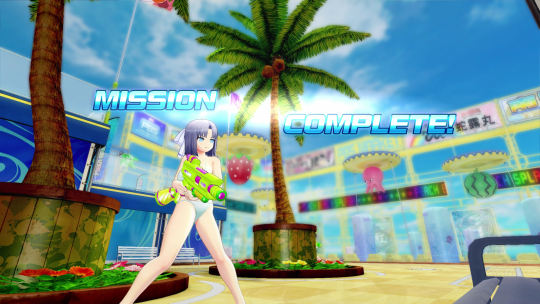
One of the themes in Peach Beach Splash is about how each of the girls has her own independent life in addition to being a member of the team. With graduation approaching (and approaching, and approaching) for several of the girls, major life choices are bearing down on them, some of which could keep them away from everyone they’ve come to love. Other prominent subplots in Peach Beach Splash illustrate how hard it can be to manage a team full of strong-willed, divergent personalities, as Miyabi struggles to keep the peace between two sets of bickering siblings.
There is a more central conflict to the story of Peach Beach Splash, and the true purpose of the tournament does come to light eventually, but the general tone of the game is much lighter than Burst, Deep Crimson, or even Estival Versus. That said, the game shapes itself up to be the girls’ last lighthearted adventure (spinoffs aside) before everything hits the fan in the next canonical volume, and there’s no telling how each girl will deal with what’s coming.
Until then, we hope everyone enjoys a wet, wild romp through a summer playground with the girls of SENRAN KAGURA.

When XSEED approached me about contributing to their in-progress The Legend of Heroes: Trails of Cold Steel port, I was immediately excited about the prospect. The Trails in the Sky series features some of my favourite JRPGs on PC, so I looked forward to making this later game in the franchise the best it can be on PC.
Of course, back at that point I didn’t quite anticipate just how involved I would get - I was expecting to do some optimization here and there, maybe amounting to a week or two of full-time work. Reality would turn out different, and in this series of articles I’ll give you some idea of why.
The series is currently planned in 3 parts, leading up to the release of the game on August 2nd:
- Thefirst part, which you are reading right now, deals with performance aspects, primarily framerates and loading times.
- Thesecond part will describe the graphical enhancements and options available in the PC version, and how they came about.
- Finally, the third part will go into some specific features of the PC port that aren’t direct graphical enhancements, and explain some of the challenges in implementing them.
The Beginning of the Performance Story
It seems appropriate for a story about a program to begin with loading, and the initial issue that I was consulted on were in fact loading times. In the PC version of the game at that point, even on a fast machine, loading would routinely take upwards of 20 seconds. And these were not some infrequent large loads, but rather loading which occurred e.g. every single time a battle started and ended. Additionally, significant loading stutters were present frequently throughout the game.
This was of course not an acceptable state of affairs. After a lengthy analysis, I figured out that the primary reason for both the stutters and the loading was that the game’s engine used Nvidia Cg (a - by now - very outdated and unsupported high-level shading language toolkit) to compile and load shaders at runtime. By caching and reusing shader compilation results, I was able to reduce loading times (after the initial load) to ~2-3 seconds, and also eliminate most stutter after a startup phase. Satisfied with the progress on the particular issue I was contacted about, I reported my findings and code.
Standards
Some time later, I was tasked with polishing up the game for its eventual release. While I spent some time improving graphical aspects in the game’s Cg-based version which existed at that point, with more playtesting I grew increasingly dissatisfied with its performance.
As the game was originally released on PS3 and even Vita (though the PC version only uses PS3-level assets and effects or better), you would expect a fast desktop system to churn through it with incredible ease. However, at that point I had already discovered a specific scene and camera perspective in which my PC dropped down to 45 frames per second, completely CPU limited. Using a variety of profiling tools I discovered that the issue was primarily related to how the OpenGL/Cg rendering backend of the engine managed shader state, ending up with dozens of state setting calls for each individual draw call. By doing some of the more obvious optimizations and tweaks, I brought performance in my testing scene up to 55 FPS. At that point, I estimated that by fully optimizing the Cg-based renderer I might get the game up to around 80 FPS on my PC in that scene at best.
That wasn’t going to be good enough.
I could never accept a port with my name on it for a game that ran on PS3 at 30 FPS which only gets up to 80 FPS on my fast 2015 desktop system. In fact, I’d personally like to run a game like this on a low-power portable like the GPD Win, and with that level of performance this wouldn’t be possible.
Changing Horses Midstream
The only true solution to the performance issue would be to completely replace the rendering backend. The underlying engine already had a DX11 backend, but unlike OpenGL/Cg it was clearly not used by Falcom during the development of Trails of Cold Steel, and the game and its assets used a very large array of features not available or not functioning in the same way in in the DX11 backend. As such, switching to the different renderer was actually a larger change in some ways than all of the PC porting work that had been done up to this point.
To give you a better understanding of what this means, here is the first screenshot I took during development of the DX11 version – and note that this was already after fixing a number of issues that would prevent the game from even starting:

In this screenshot you can see over a dozen separate rendering issues, some of which required fundamental engine extensions and reworking to fix. However, they were still just a subset of a final tally of 57 separate classes of rendering problems (not individual instances) related to changing the rendering backend. There’s no way I can go into all of them, but here is a particularly amusing one I was tracking at a much later point during development - as you can tell by everything no longer being a horrible mess:

The Result
Regardless of all these issues and the effort required for porting to an entirely different rendering backend, it was all worth it in the end. The following chart gives you an idea of the (CPU) performance of the game on my PC at various stages in development:

The current state of the game, designated as “Optimized DX11 version”, is more in line with what you would expect from a good PS3 to PC port.
I’d like to note one important fact about this chart: please don’t quote it as some kind of argument for how much faster DX11 is compared to OpenGL - this result is a direct consequence of how these APIs are used in their respective rendering backends in the underlying engine. I assume that the GL/Cg version is designed more as a development aid to very closely resemble the console targets than for performance on PC.
Reaching almost 300 FPS on a high-end PC is nice, but ultimately rather pointless in a turn-based JRPG. What is more interesting and the real fruit of all this effort is performance on a really low-end system, such as the GPD Win portable. This video shows the game running on that device, and as you can see the mission of smooth gameplay on a portable at native 1280x720 resolution was accomplished. In terms of settings, this video uses the game’s “portable” settings, and what exactly that means - and also some ways in which the PC version will allow you to spend the massive performance overhead on a fast desktop PC - will be the topic of my next post about Trails of Cold Steel on PC.
“Rally-ho, true believers!” I shout, swinging into the grand hall on a chandelier, interrupting the fancy party. Everything stops as eyes are focused solely on me – on my roguish good looks, my brand-name tabard, my elk leather highboots. I somersault to the floor, landing on my feet with a flourish and a bow. “I know you must have thought this high society gathering dreadfully dull without me here to tell you about the intricacies of composing prose for novel electronic amusements, so I’ve come to enlighten and entertain thee. Also, did you know all the food here is free? My pockets are full of cocktail wieners right now.”
Indeed, it’s an honor to see you again, dear readers. I hope you enjoyed my previous blog about the upcoming PC release of Zwei: The Ilvard Insurrection. As a small refresher, it served as something of an introduction to Zwei: II as a game – what it’s all about, its two main characters, the setup of the story, and its battle and leveling system. You can think of it as a sampler platter to give you a taste of why this game’s cool.
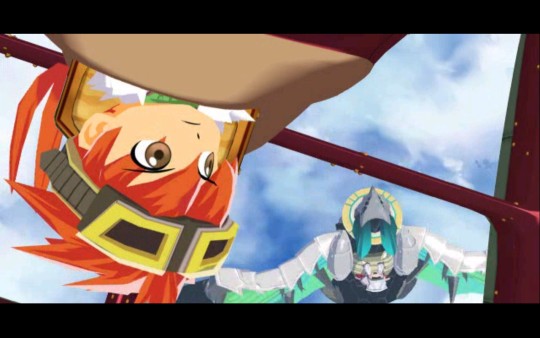
Do a barrel roll
Today, in my second Zwei: II blog, I’d like to go into more detail on the process of writing and editing for the game, and some of the things I dealt with and thought about as I localized it. I’ve done an entry like this for each of my prior projects, and I always enjoy it because it gives me a chance to briefly pull back the curtain and share with you some of the minutiae of localization, and the truism that every project is its own beast.
One interesting thing of note about this project is that it’s the first project on which I served as the sole editor. When I started working at XSEED, most of my prior localization experience had been as part of a team working on large single projects, while most of XSEED’s workflow at that time had been to keep a single editor on a project as much as possible. Each method has its own benefits, as you’d expect. When I work with a partner or team, I enjoy being able to bounce ideas off them or ask for hot takes any time I want, like, “Okay, which of these five potential quest names sounds the best to you?” or “Here’s what I have so far for this scene, but I want this girl to sound more disinterested. How would you do it?” We solicit general impressions from the office fairly regularly, but having other editors acquainted with the specifics and setting of the project you’re working on gives you access to an informed, expanded scope beyond your own intuition and experience. That’s important, because every editor is naturally going to have some characters or scenes they click with more readily than others.
On the other hand, flying solo can also be nice because it represents a purer distillation of editorial voice. With single-editor projects, you know that all the text in the game was overseen by the same person, making thoughtful choices with full knowledge of where everything fits in the greater scheme of the story. I think that’s what XSEED values about this methodology, but with the arrival of mammoth-sized scripts like those for the Story of Seasons and Trails of Cold Steel games, it became a matter of practicality to learn to work well as small teams on projects – a challenge I think our editors have risen to meet in admirable fashion. Of course, that’s not to say I didn’t have a lifeline or two working on Zwei: II. Junpei and Tom were an ever-present source of support whenever I had a question about something in the Japanese – and there were many, many of those over the duration of the project. Even when you’re working alone, you’re never truly alone when you’ve got the office familia backin’ you up.

Getting to work on a project by myself has also helped me better understand my own work process. One nice thing is that everything I mentally bring to a project – the stories I’ve consumed and experiences I’ve had that color how I interpret characters and scenes – remains consistent throughout. This is especially pertinent when writing for comedic scenes, as no two editors will have the exact same sense of humor, and Zwei has more than its share of wisecracks and comedy. The scary thing about being the sole face of a game, though, is that anything that’s weird or wrong, any jokes that totally fall flat, emotional connections that don’t get made – that’s all on me. In a way, it’s a test of myself as a writer and editor, with you all as the judges. With the original Story of Seasons, Tom and Ryan lent me a hand, and I had the dashing Young Kris as my partner for the first Trails of Cold Steel, but here, you get pure Nick, for better or worse (hopefully for better).
I mentioned briefly in my previous blog that Zwei: II felt like it was deeply informed by ’90s anime and manga, and I’d like to unpack that a little more for you here, in case your curiosity was piqued at the notion. After all, a lot of the games we work on here at XSEED are pretty anime-flavored, right? What’s one more on the list?
Here’s my take. Over time, the general vibe of anime has undergone change, as all thriving arts tend to. One major difference – the one most relevant to our discussion – is the observation that protagonists in many modern series tend to be passive, disaffected, reticent, or otherwise hesitant to engage the world and situations around them. They’re the reactive sort. Sometimes it’s because they’re exceptionally socially aware. Sometimes it may be because they’re awkward youths. Sometimes it’s because you get the impression that the writer really wants you to think this person is cool or above it all. Anime from the ’90s, on the other hand, is much more associated with protagonists who leap into situations without thinking, do things without considering the ramifications of their actions, and adhere to a personal code or philosophy that the character consciously or unconsciously holds. Both approaches, in the hands of a good storyteller, can and have made for some great entertainment, but from a writing perspective, the “’90s anime” types are definitely easier for me to work with. They’re more expressive, more willing to engage, and their very being tends to create conflicts that help drive the story and the growth of both themselves and other characters.

During the time I was working on Zwei: II, I actually ended up rewatching a season of Ranma ½ (those blu-rays are preeeeetty sweet) and seeing the Tenchi Muyo TV series for the first time (on loan from Tom). Seeing those really made this whole point click with me, like, “…That’s it! That’s the kind of comedic stylings Zwei is trying to channel!” Not in the sense of specific plot points or characters from any particular series, but the sort of atmosphere that was about creating opportunities for amusing things to happen. Ranma, for instance, tends to nettle many of the characters in his series not on purpose, but just by being who he is. And not just that – doing it on purpose also comes very easily to him (just watch how he loves to bait Ryoga or Kuno with his taunting). Ragna is less purposefully ornery, but his decisive personality draws the admiration of some and the exasperation of others. Plus, later on in the game, you run across a genuine hot spring, and we all know what a staple of the era that is. ;)
You’ve probably heard the saying, “Tragedy is easy, comedy is hard,” and there’s truth in it. Most of us love a good comedy, but do any two of us love all the same comedies or laugh at all the same things? Humor is deceptively difficult because it’s so mercurial, influenced by the times, by moods, by delivery, and more. A bit that might leave you stone-faced Monday night could have you busting a gut Thursday night. Understanding why something that makes you laugh does so is the study of a lifetime. There’s really no shortcutting it – you have to get the mileage, experiencing things that make you laugh, thinking about why, and chasing the next thing you think might give you another shot of mirth. I can only hope that I’ve imbibed enough of the spirit of humor to properly convey the charm of what is perhaps Falcom’s most levity-laden title.
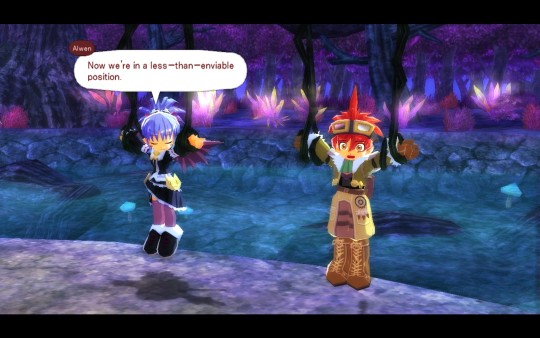
Yeah…just hangin’ in there, y'know…
Beyond my approach to the game itself, we have its characters – the heart and soul of the action. Quite often, early on in the process of localizing a game, I’ll get an impression of a character as, “Oh…I guess he’s a lot like X from [other source],” and as I make a couple of those anchoring connections and begin considering the characters in the game from those perspectives, they begin to show their multiple facets. Lest you think this sounds too close to, “Oh no, he’s just taking an existing character and foisting that persona on this carefully crafted, unique game character!”, take a measure of comfort in my assurance that I, too, would be dissatisfied with an approach that oversimplified. Think of it more as a basic framework – scaffolding that lets me clamber around the object d’art to get at the fine detailing.
With Ragna, for instance, his characterization is very front-loaded in the game. Right away, you know he’s a freewheeling pilot, sort of a hotshot, and likes to do things his own way. The image he creates is very “early 20th-century flyboy,” and I sort of conceptualized him as a guy who wouldn’t feel out of place if you stuck him in among the cast of “The Rocketeer.” Speech-wise, his alternating between laid back and fired up reminded me of Gundam Wing’s Duo Maxwell, and like that character, Ragna likes to chime in with some tongue-in-cheek commentary if something patently ludicrous or weird happens in the game. Finding characters who are reasonably like the one you’re writing for helps, as does understanding the milieu in which a character exists – what they were doing just before the story began, and what the world around them that shaped them is like.

There are actually a couple characters who have what I termed “Ragna-variant” speaking styles. Ragna’s main vocal tic is that he sometimes truncates words ending in “-ing” (so “nothing” would become “nothin’,” and “fighting” would be “fightin’,” though I tried to generally keep it to one per text box – it’s a spice, not a marinade), so among the expanded cast, you get some people who speak that way because they have similar lifestyles. Odessa, as a rough-and-tumble Treasure Hunter who specializes in capturing bounties, is very colloquial in her faux old-west style. Gashler, who runs the garage out by the airstrip, is a full-bearded, goggled mechanic that sort of reminded me of Cid from Final Fantasy IV, and his speaking style is pretty thick – one of the most affected in the game, though I tried to make it still pretty easy to comprehend. One also has to consider that people who have special styles of speech have certain occasions where that’s either suppressed somewhat, or is expressed with even greater emphasis than normal. Even old man Gashler might speak (mostly) standard English if you dragged him to a black-tie event, but on the other hand, if someone said his workmanship is rubbish, I have no doubt that he’d be cussin’ up a storm, blastin’ furnace-fire, and lettin’ loose with the sort of strange, idiomatic expressions that only grease-stained mechanics know.
Ragna being an unusually “American-feeling” character made him pretty easy to write for right from the start. Alwen took a little more finesse and more time to find her ground – but not because she was difficult in a conventional sense. The trick with Alwen was that she definitely inhabits a certain archetype, at least partially, but I needed to figure out how much of that I needed to accurately represent her, and when to let her individual characteristics shine.
Alwen, as the daughter of an esteemed Trueblood vampire house, can be very prideful, bordering sometimes on haughty. She learns fairly quickly that the world beyond her castle has more complexities than she gave it credit for, but her distance from the world of humans actually gives her some surprising insights. Now, the most common way you see characters like Alwen played are that they step out into the greater world, eventually realize how much they don’t know, and depend on their friends to teach them what it means to really live along the way. Alwen…has some of that, but it’s the way she interfaces with the world that makes her an interesting and fun character. For example, she doesn’t technically NEED to eat food, but likes eating a ton of it (on Ragna’s dime, of course) just because it’s tasty. She’s not afraid to walk right into town and make small talk with the people. Alwen may be a vampire, but she’s refreshingly (and oddly) free of so many of the preconceived expectations people have about what vampires are like. She even calls Ragna out on this early on in the game when he’s shocked that she walks around just fine in the bright morning sunlight. A great deal of Zwei: II’s story is really her story, especially when it comes to getting the ball rolling, and it helps the story greatly to have a character who both entices with a bit of the familiar but also stands out due to individual quirks.

I also did with Alwen a variant of what I did for Laura in Trails of Cold Steel, where I shifted her from talking with a “proper,” antiquated style of speech to a more natural speaking style that still retains the idea that she’s highborn. Coming at this from a lore perspective, Alwen hasn’t been out of her castle in the last 100 years or so and has learned what she knows of the world from her estate’s extensive library, so it would be very feasible for her speaking style to sound older than that of Ragna or the people of Artte. In practice, though, Ragna having a casual style of speech and Alwen’s speech being fairly rigid made it difficult for the comedy to land, and to really connect with Alwen as a character. Can you imagine what Star Wars would’ve been like if Princess Leia spoke like a medieval fantasy princess while trying to banter with Han Solo? That’s the kind of disparity I’m talking about. It might’ve been funny, but for reasons entirely unintended. So after thinking on it a while, I decided to adjust Alwen’s speaking style, dialing it back. My priority was to keep her sounding articulate and well spoken, but casual up the language so that the banter between her and Ragna has the requisite snap it ought to. In my opinion, the net gain from that was well worth the adjustment, which you’ll be able to see for yourself when you play.
Sort of tangentially related to that, in the Japanese version, Ragna goes through basically the whole game calling Alwen “Princess” (“hime-san”). The best reasoning I could figure is that maybe, having taken on some power from their blood contract, Ragna feels he should acknowledge her as his liege, but…that explanation totally flies in the face of Ragna’s personality. Ragna is a guy for whom there is ONLY a first-name basis (or a nickname if he finds one for you he likes). The most likely explanation is that it’s just the difference between politeness levels in Japanese personal address versus Western personal address, but the title put a certain amount of “distance” between them that I didn’t want to remain there for the duration of the game. The alteration I made to compensate for this was to have Ragna refer to Alwen as “princess” a bit at the very outset of the game, but quickly fall into using her first name, which feels much more natural for the character. To draw the analogy with Star Wars again, think of it as Han Solo going from calling Leia “princess” or “your worship” in a sort of snarky context when he doesn’t really know her to simply calling her “Leia” once he’s spent time with her and knows her as an individual. Plus, with as big a deal as Ragna makes over wanting to work together with Alwen as “equal partners” at the start of the game, it would be weird for him to then go on to refer to her by her royal title for the rest of the game.
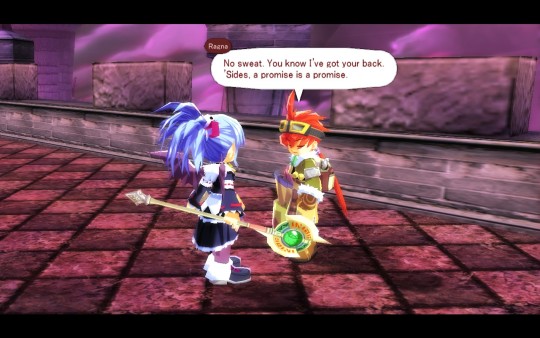
This discussion isn’t meant to be a comprehensive retrospective of Zwei: II’s localization, of course; just a list of some of the noteworthy things I grappled with working on the game. Editorial work does have its pressures and difficulties – when the buck basically stops with you, how do you know you’re making the right call? – but ultimately, these kinds of challenges are what keep the job fresh and interesting. The point of all the character personality profiling, the speech styles, the fine-tuning, is for players to be able to sit down and experience a fun story and memorable characters that “just work,” no speculative microscope examinations of the translation required. I think my obsessive tweaking and spit-polishing will make for a better game experience…but you don’t have to take MY word for it. Give Zwei: The Ilvard Insurrection a try when it comes out and see for yourself!
Howdy, everybody!
We’ve been busy with E3 here at XSEED, but don’t think for one second that we’ve forgotten about the Story of Seasons: Trio of Towns patch and DLC. We’ve been working on it for several months now, and I’m happy to say that it’s close to completion.
First, let me give you some general information about the patch/DLC, and the effort necessary to localize all of it.
The Japanese patch contents, released in four updates over six months, contained about 210,000 Japanese characters. While this is around a tenth of the total game text, it was still no mean feat to localize, as we anticipated when discussing it in a blog several months ago. We were lucky to have one of the translators who worked on the game back, and I filled in on about a third of the text myself. Our editors were Danielle–by now a veteran of the series–and Nick, who was the project lead on the first Story of Seasons and is a master of puns. Given this, I assigned Nick most of the text for new marriage candidates Woofio and Stephanie, and he did a really bang-up job. He kept a running list of scribbled dog puns while working on Woofio’s text, and as the frowny face indicates, sometimes things got a little ruff.
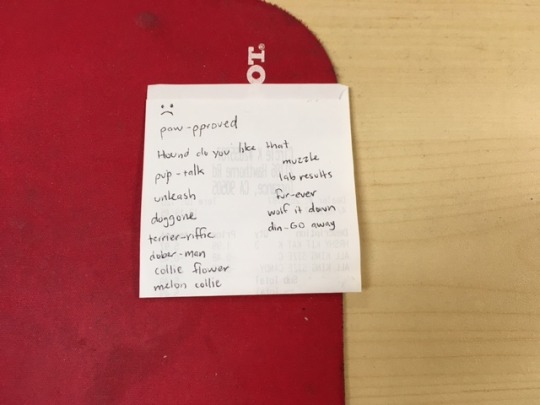
Look for these in the DLC!
In Japanese, Woofio’s doggerel is mostly expressed with the sentence ending “-wan,” which is the sound that dogs make in Japanese. His Japanese name—Wantatan—even uses it. This is similar to how cats and catgirls use “-nyan.” Woofio’s Japanese dialogue does contain some animal puns and references, but the brunt of the work of characterizing him as doglike is done through the almost constant use of this “-wan” grammar. Because English doesn’t have a similar structure, we had to get a bit cleverer (and by that I mean dumber) for our text. That said, we were careful not to overdo it, as that wouldn’t have been true to the spirit of the text either. I don’t know about Nick and Danielle, but I had a lot of fun localizing the DLC.

Having fun with a rejected eShop icon.
The two new characters are additions worthy of being listed among the series’ strange lineup of secret marriage candidates, but there’s also a lot of content included for those with no interest in fursuing Woofio or Stephanie. There are several events for those who have already gotten married or built great relationships with the three towns, including a post-wedding visit from your family. From what I’ve seen online, players seem to either love or hate Daryl, but I think it’s fun to watch how he interacts with your spouse. And, of course, your spouse’s reactions are very cute too.

Daryl, your serious dad, meets your husband, the guy in the dog suit.
There is also an event where you host a little party for the bachelors (if you’re playing as a male MC) or bachelorettes (female MC). In this event, the variety of dialogue you’ve come to expect from this game is on display, as the characters make comments on whichever interior design you’ve chosen for your house. The DLC also features a lot of new dialogue for each marriage candidate, as well as some new costumes. As you might have heard, you can also now have a child with Inari, the secret marriage candidate. The patch/DLC will also be applied to your current save data, so you won’t have to start a new game for this to happen if you’re already married to Inari.

If you couldn’t guess, Stephanie’s favorite color is pink.
You’ll have to wait a bit longer for a breakdown of the exact details of the patch/DLC (including price and release date…sorry), but the free patch will include some bug fixes, typo fixes, and a new menu that will let you purchase the DLC from the eShop. One of the bug fixes is the Ludus Beverage Bash progress stopper. This was the first thing I confirmed when we received our first version of the patch data. We’ve also fixed the bug that won’t let players designate a furmiliar from the 7th spot or lower on their pet list. For typos, we’ve been able to fix the major issues—the seasonal suns being mislabeled in the cellar, the repeating dialogue in a few events—as well as some other issues that players have pointed out. A lot of these fixes are thanks to your feedback over the past few months.
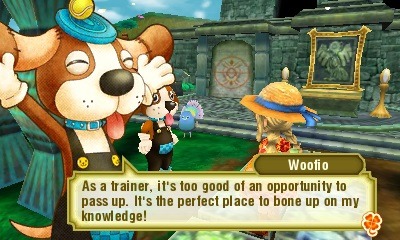
As far as Woofio puns go, this one is pretty tame.
The free patch will also include text from the Japanese patches that we consider to be “fixes” rather than added content, such as tutorial text listing out the contents of each ingredient group used in recipes, and a warning from the part-time job recruiters to pick up delivery orders before the shop closes.
Reaction to Trio of Towns in North America has been really wonderful so far. I think that’s a testament to how much the game both refined the series’ mechanics and included a level of character detail that was previously unseen. I’m excited for the patch and the DLC to improve the experience for players even further. Stay tuned for more updates.
Excelsior, true believers! Nick here again, penning these gladsome tidings from my grand scriptorium full of musty scrolls and ancient cartridges. Alas, it’s been quite a while since I checked in with all of you – well over a year, in fact, with the release of the first Trails of Cold Steel. With that giant title now roaming free in the wild like the majestic brachiosaurs in Jurassic Park, you may have wondered what I’ve been working on over the course of the last year. It always seems to unintentionally happen that I get assigned to projects I can’t talk about for significant lengths of time, but this stretch has easily been the longest. So many times I’ve wanted to tell you some quirky story or fun little side-note about this game as I worked through its script, but alas, the official XSEED duct tape was covering my mouth – until very recently, that is.
In our yearly lead-up to the gaming extravaganza that is E3, we finally announced my long-in-coming project: the classic Falcom action RPG Zwei 2, making its debut outside of Japan as Zwei: The Ilvard Insurrection!

Of course, I’ve also helped out with a variety of other, more time-sensitive projects, leading to Zwei taking a bit longer to bring to you than it would have otherwise, but I think we’ve got something you’ll really enjoy in the making here. And conveniently, the benefit of the slow going is that the release isn’t too far off now. As Zwei II enters its final stretch before release, I wanted to tell you more about the game – which is exactly what I’ll do, over the course of the next couple weeks.
Zwei II has an interesting history: released in 2008, it was the very last game Falcom developed exclusively for PC. Back then, the PC gaming market was far from being the robust, thriving scene we know it as today, especially the Japanese market. Thus, the title seemed almost fated to fly under the radar despite its quality craftsmanship and hours of fun. But now, with the worldwide PC game market booming and digital storefronts ensuring copies can get into the hands of anyone who wants to play, it felt like the right time to fill this conspicuous gap in Falcom’s lineage.
“But…what about the first Zwei?” you may be pondering aloud to your monitor. If you’re wondering whether you’ll be at a disadvantage playing the second game in the series before the first, worry not! I’ve played both (thanks to Tom’s Japanese boxed copies) and can confirm that Zwei II gives you all the info you need to understand the world, its plot, and its characters. There was a 7-year gap between the first and second Zwei games in Japan, and Falcom couldn’t assume players would’ve played the earlier entry, so the structure is something more akin to Trails in the Sky versus Trails of Cold Steel, where the games take place in the same world, but in different locations and with different casts. This makes it easy to jump right in.
To start things off, I wanted to sit down and flesh out the game a little for you, since compared to its siblings in the Ys series, and even Xanadu, it’s far less known by fans. What is the Zwei series? What makes it great? How does it play? Why is it cool?

Let’s start from the ground up: the name of the game. “Zwei” is simply the German word for “two” and, as you’ll soon discover, it’s a very fitting title – the game features not one, but two protagonists. Our leads in Zwei II are Ragna Valentine, a lively treasure hunter and pilot-for-hire, and Alwen du Moonbria, a confident vampire princess looking to avenge herself against an unknown enemy. How these two very different people meet and come to really understand (and maybe even appreciate) each other is the relationship that forms the heart of the game, and I’ve done my best to make that journey of growth and understanding a fun and memorable one. And, as with any good RPG, the journey is not without obstacles to overcome. Fortunately, our hero and heroine are up to the task, with Ragna skilled at mixing it up in melee, and Alwen versed in the ways of magic. You can swap between them at any time, and whoever you’re not controlling runs along behind you, ready to leap into the lead role at the press of a button.
Zwei II’s combat is action-based, not unlike the Ys games or Gurumin, but the two-character setup creates an interesting dynamic in combat. Over the course of the game, Ragna will be able to upgrade his weapon, the half chain-whip/half katar Anchor Gear, into several different forms, and Alwen (who begins the game bereft of most of her magic) will regain her powerful spells. You end up being able to do some interesting things, like using a claw-variant of Ragna’s Anchor Gear to grab an enemy, then throw it into another enemy, knocking both into a corner, then swapping to Alwen and unloading a fiery salvo on them. Or have Alwen cast her whirlwind magic to sweep up a couple enemies and keep them stun-locked, then swap to Ragna to leap into the air and string together a midair combo on them. In many dungeons, I often found myself favoring one or the other to take the lead because of the strategies I came up with to best deal with certain types of enemies, and you’ll likely fall into styles of play that fit the way you prefer to approach the game’s combat as well.

And speaking of approaches to combat, Zwei II has a rather unique leveling system, too. In the game, you don’t earn EXP from quests, or from beating up monsters. You actually earn it by eating food – the same food you use to heal yourself when you’re running low on HP. There’s even a “food exchange” service available at the restaurant in the main village of Artte that lets you trade 10 of any one type of food for one of another type that gives more EXP than the ten individual pieces of food would have if eaten on their own (example: trade 10 cheeses worth 10 EXP each for a single pizza worth 150 EXP). Will you chow down now, or hoard in the hopes of cashing in for savory plates of EXP-rich cuisine? You decide! It probably sounds weird (it certainly did to me when I first learned about it), but in practice, it actually works really well. It frees you up from having to grind in dungeons, or feel like you absolutely MUST kill every enemy on the way to your destination. It also gives you a lot of control over your own challenge level. When I was playing the Japanese version of the game, my loose rule was that I’d never eat food just to level – I’d just use it when I was hurt, to restore HP. I ended up going through most of the game under-leveled because of this, but never TOO under-leveled, because the more under-leveled I was, the more damage I’d take, thus getting infusions of EXP more frequently from using food to heal myself. There’s a strange sort of balance to it, and the game isn’t stingy about giving you food in chests, as drops from enemies, and even from giant slot machines you’ll find in each dungeon, so you can decide whether you want to blow through the game as a force of nature but with less on-demand healing available, or a bit underpowered but with a fully-stocked pantry.
If that talk of slot machines that dispense food or trading wedges of cheese for a pizza sounds a little…weird, that’s by design. More than any Falcom game I can think of, the Zwei series embraces its sense of humor, poking in good-spirited fun at its two main characters, the townspeople, and even many of the foes you face down along the way. It’s got a lively, colorful, and cartoonish art style that has helped the graphics hold up well, too. You probably know from personal experience that stories more focused on being comedic sometimes run the risk of not being able to successfully shift into a more serious mode when the story calls for it, but thankfully, Zwei II doesn’t suffer from this issue. It’s surprisingly adept at conveying a serious atmosphere when the story calls for it, making for some excellent dramatic moments, and even a dab of pathos here and there. But on the whole, Zwei II is a game that feels deeply informed by 90s anime and manga, with all the oddness and charm that comes with that. I can certainly say that being rooted in that style proved fertile ground for my work to help the game achieve its comedic potential (speaking as a weeb from ancient times), and I’m already planning my next blog post to focus on some of the details of the writing and the characters.
One thing I love about Zwei II is that it reaches out and really grabs you from the start. In just the first 20-30 minutes, you get the following ace setup (obviously, skip these next two paragraphs if you want to go in totally blind):
The game begins in the skies, as courier pilot Ragna Valentine is cruising in his cool red biplane, the Tristan, toward the island of Ilvard on a routine delivery mission. Suddenly, he’s ambushed by unknown assailants, and after a dogfight against a pair of dragon-riders in the skies over Ilvard, his plane takes a bad hit and plummets toward the land below. The next thing he knows, he wakes up in a bed in the nearby town of Artte as the town doctor marvels at how he came out of such a crushing impact with barely a scratch. After all, his plane didn’t fare nearly as well. Going out to investigate the crash site, Ragna finds his plane on a hill on the outskirts of town, busted up and snapped in half just as the doctor said. So how did he even survive such a nasty crash?

Well…he almost didn’t. After that crash, as he lay among the wreckage, broken of body and bleeding out, he was rescued from his mortal fate by none other than Princess Alwen du Moonbria. Alwen isn’t your ordinary RPG princess, though: she’s a sharp-tongued shut-in vampire princess. Not too long before the start of the story, Alwen’s castle was invaded by a mysterious foe who ultimately seized the stronghold and gave her the boot, after stripping her of her ancestral magic. Seeing the outsider Ragna as her best bet to help her search for her magic and retake her castle, she takes some of his blood and gives him some of hers, sealing a pact that turns him into her ‘Blood Knight’ – a warrior in thrall to a powerful Trueblood vampire whose physical abilities and regenerative capacity far exceed what humans are capable of. But Ragna, see, is all about freedom and doing things his way, and he hates the idea of working as anyone’s lackey. After realizing the situation he’s in, though, he strikes a deal with Alwen: he’ll help her get her castle back as thanks for saving his life…but instead of being master and servant, they’ll do it as equals.
And so, our story begins.
Cool, right? And that all happens in fairly short order – no longwinded tutorials, no hours of quests before the gears really start to spin. Zwei II has a lot of heart and a lot of dialogue, and to its credit, it seldom feels like it drags. The story starts with a bang and keeps things moving at a good clip.
That’s not to say there isn’t plenty to do, though. The island of Ilvard is dotted with thriving communities and, in the fashion of the Trails or Ys games, they’re populated with fleshed-out NPCs who have their own small story arcs and conflicts to overcome over the course of the game, with dialogue that changes frequently after progressing the main story. Some of the residents are funny, some are petulant, and some are just downright strange, so I hope you enjoy getting to know all of them over the many times you’ll visit the towns. You might even stumble upon unique scenes, a secret hint, or a good ol’ fashioned RPG quest (you know, the kind from back before there were convenient quest logs to keep track of things). And of course, what with Zwei II being focused on Ragna and Alwen as dual protagonists, they’ll often have unique things to say in response to other characters depending on whom you’ve got in the lead.

In the course of working on the game’s script, I observed with no small amount of fascination that in some ways, it almost seems like Zwei II was made more with Westerners in mind than the Japanese market. Ragna himself is an incredibly un-Japanese character, with his bravado, easygoing swagger, and sass, but he’s a character that I know will click instantly with the North American audience in particular. We see Ragnas in our books and films; we all probably know someone like him, or who has elements of his personality. Alwen, too, is a character I think will be well-liked by the West. Not content to lament the loss of her home or sit idly by, she picks herself up and decides to get even and take back everything that was taken from her even though it promises to be an uphill battle. The core of her personality is her self-assured nature – even when confronting a world she’s mainly just read about (in books that were, sadly, out of date on the latest trends and customs). Quick-witted and keen, she matches Ragna tit-for-tat, helping the two play well off each other. Beyond just them, there’s the wild west-flavored bounty hunter Odessa, chain-smoking nun Isabella, the worldly jazz pianist Shester, dependable engineer Miriam, and of course, the irrepressible luchador-masked man of mystery, Gallandeau, among many others. Having a zany cast of characters like this all together in one place feels like the kind of storytelling we enjoy so much in Japanese games. But at the same time, after seeing so many forgettably milquetoast light novel-style characters in the games and anime of recent years, it’s refreshing to come upon a game where the characters have an abundance of personality – where I know they’ll resonate with the audience I’m localizing the game for.

So…there you go. In a nutshell, this and more is what you have to look forward to when Zwei: The Ilvard Insurrection finally makes its debut. Like a time capsule laden with the charms of a bygone era of RPGs, I think it’ll prove its worth to you as more than simply a pleasant surprise – I think it has the merit to stand proudly as one of Falcom’s finest.
With the release of AKIBA’S BEAT for PS4 and Vita alike less than a week away (or just over a week away, if you’re in Europe), we thought it might be nice to take a closer look at the game’s “Delusionscapes” – the dungeons created within the Tokyo district of Akihabara that make up roughly one half of the game’s playtime. Some fans have been unclear as to what these are and how they work, so we figured we’d show you some of the original concept art from several choice Delusionscapes, along with providing thorough descriptions of how each one – and the delusion that spawned it – fit into the game’s setting and overall story.
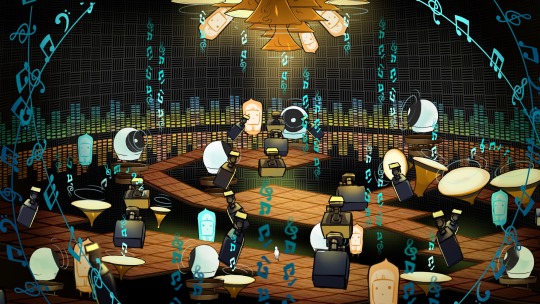
Audio Delusionscape
For a brief moment in time, Akihabara was an audiophile’s dream, with stereo equipment plentiful and knowledgeable staffers on every corner. But when’s the last time you saw someone excitedly buying a several thousand-dollar boffo stereo setup with amp, subwoofer, big honking speakers, etc.? I’m willing to bet it wasn’t anytime since the turn of the millennium, and Akihabara – its finger ever on the pulse of current technological trends – reflects that, with the audio niche being all but gone from the Akiba streets of today.
One of the central themes of AKIBA’S BEAT, however, is that sometimes, people simply cannot accept change… and in the Akiba depicted here, those who have a strong affinity for the way things used to be can actually change reality to make it that way again.
One music hipster dude, who runs one of the few surviving audio specialty stores in Akihabara, did exactly that, and created this Delusionscape full of the most amazing audio equipment you’ve ever seen (with perfect acoustics, no doubt!). And where did he create it? Why, at the heart of Akiba, of course: Akihabara Station, where all those heading to or from the district inevitably must go. From the outside, it just looks like the station’s got a larger-than-life sound system attached to it, but on the inside, it’s a maze of graphic equalizers and top-of-the-line gear.
The key part of this delusion, however, is the effect it has on the people of Akihabara, unconsciously causing Akiba residents and tourists alike to have a strange desire to go out and buy new audio equipment…

Idol Delusionscape
Cuteness, pinkness, and bunnies rule the day here, as the site of a simple concert fronted by up-and-coming idol singer Riyu Momose turns into an absolute idol paradise. Throngs of adoring (and rather creepy) fans flock to the site, guided to it like a beacon in the night, leaving our heroes with a bit of a conundrum: who among this crowd of hundreds – nay, thousands – could be the “deluser” responsible for dreaming up such a venue?
On the inside, the Idol Delusionscape shares its outer appearance, but dials it all up to eleven with neon color-changing lights and whimsical designs around every corner. One can only imagine the Grand Phantasm (read: boss) that awaits at the end of such a high-energy labyrinth!
The Idol Delusionscape is when the story of AKIBA’S BEAT really starts to kick into gear, presenting players with a large list of suspects as to who might be responsible for its creation, and forcing them to do some true sleuthing in order to find the answer. Is it the jovial yet overbearing Chunk Widebody? The scrawny, sweaty, and devious Twiggy Slims? Or perhaps it’s the shy, awkward Megane Taro, who seems – by all accounts – to recognize that something isn’t quite right about all of this…
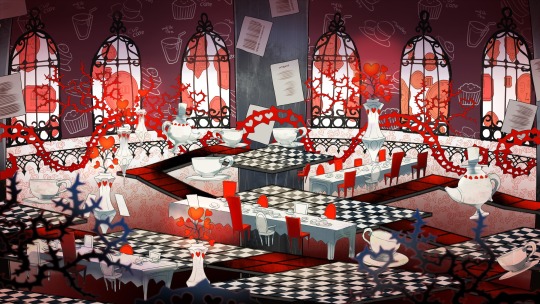
Maid Delusionscape
As with the Audio Delusionscape, this one represents a period in Akiba’s history that’s only just now starting to come to a close: the maid boom. Maid cafes are a staple of Akiba culture, allowing reclusive “otaku” (read: nerds) not only to eat lovingly prepared food full of hearts and flowers and frills, but to have cute girls in maid outfits waiting on them hand and foot the whole time, calling them “master” and doing everything in their power to cheer them up with song and dance routines, magic shows, games… whatever it takes!
Maid cafes are still abundant in Akihabara today, with locations like Maidreamin and Granvania serving as landmarks to travelers in the district, and girls in full maid outfits still handing out sale flyers to passers-by on a daily basis. However, if you went back in time only a few years – roughly to the period when AKIBA’S TRIP: Undead & Undressed was released – you’d find maid culture to be more of a dominant force than it is today. In other words, it’s still going strong… but it’s noticeably waning, losing ground to idol culture and other otaku whims.
This is where the Maid Delusionscape comes in. From the outside, it appears as a beacon of maid symbology (frilly lace, rice omelettes with ketchup hearts drawn on them, etc.) at the site of an in-universe branch of the “Maidiators” cafe – and this carries through to the inside as well (albeit with more imagery of bars and chains, suggesting the “deluser” responsible for this delusion might feel a bit trapped). But it’s the effect the maid delusion has on Akiba that’s most noticeable, essentially restoring the maid boom in full… and then some. As long as the Maid Delusionscape exists, maids will be more popular in Akihabara than ever, surpassing their peak numbers from the early-to-mid 2010s. And if that happens… well, it doesn’t sound all that bad, does it? But one could argue that it’ll cause the district to be thrown out of balance, losing its propensity for change. And without that, Akiba just isn’t Akiba anymore!
As such, the Maid Delusionscape chapter is the first time the game’s characters really start to ask: is it right to destroy someone’s delusion, even when it doesn’t seem to be doing any harm? Should delusions be condemned simply for “defacing reality”? Or should they, under certain circumstances, perhaps be embraced?
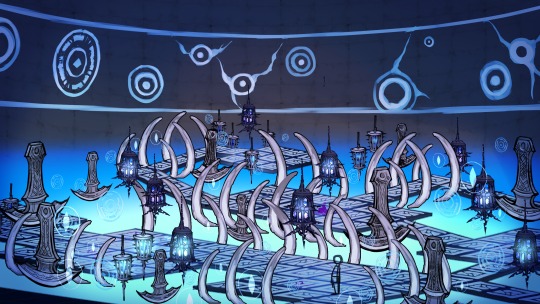
“Chuuni” Delusionscape
There are numerous Japanese terms that come up so regularly in the anime fandom, they’ve basically become adopted into the worldwide “anime lexicon” at this point. “Baka,” for example, is a word most anime fans know means “idiot,” and “tsundere” is a word most anime fans know refers to someone who’s mean and abrasive on the outside to cover up her (usually her) inner emotionality.
One that doesn’t come up as often, however, but is absolutely key to understanding the story of AKIBA’S BEAT (and is thus left untranslated, but clearly outlined to players during the course of the game, even in the original Japanese), is “chuuni.” Literally “junior high sophomore,” it’s an abbreviated version of the larger slang term “chuunibyou,” or roughly “eighth-grade sickness.” This somewhat derogatory term refers to people who are obsessed with the types of “edgy” things typically associated with fiction targeted toward eighth-graders: large unwieldy swords, characters with mysterious pasts, pretentiously poetic dialogue that obscures the meaning of crucial passages, heroic acts of self-sacrifice, focusing one’s power “over 9000,” etc.
This Delusionscape, then, is fairly low-key and personal compared to a lot of the others in the game. Its effects on the district are minimal, but those who dare to enter it are met with a unique brand of opposition in the form of a dark-cloaked man with a large axe who speaks in riddles. The key to passing by him is solving his riddles, and the key to that is finding the source of the delusion – the person who dreamed up this den of tired anime stereotypes in the first place. But can that be done before the power of the Chuuni Delusionscape collapses in on itself like a neutron star?! Find out next time… on AKIBA’S BEAT!

Electronics Delusionscape
This is one of the more surprising Delusionscapes in the game, I think. When you hear “electronics,” you probably aren’t picturing quite what you get here – verdant green grass and moss, with a general feeling of nature encroaching upon everything around you. How does this relate to electronics? Well, if you look a bit closer, you’ll see: mixed in with all the foliage (indeed, almost camouflaged by it) are air-conditioning units, fans, microwaves, washing machines, refrigerators, and all manner of other home appliances (you don’t actually have to look THAT close in the concept art image, but in-game, these appliances are a bit fewer in number and more well-hidden). These aren’t the electronics that first spring to mind when most of us hear the word, but make no mistake: these are the electronics that made Akihabara what it is today. And here, they’re shown as being forgotten… abandoned… left out for so long that they’re overgrown with moss and vines, likely never to function again.
This is the delusion of someone who controls a vast empire of home appliances, but either regrets that he’s still living in Akihabara’s past, or is afraid his goods will be rendered obsolete by newer, more advanced inventions. It’s the delusion of an insecure store owner – the hidden underbelly of a “home appliance boom” that’s happening on the outside, with people suddenly snatching up home appliances in droves like never before… when in reality, one rarely goes to Akihabara for home appliances these days. The meaning of “electronics” – indeed, of “Electric Town” in general – has changed into a completely different beast over the last few decades. And there are clearly some who would prefer not to change with it, and will fight tooth and nail to keep things the way they once were.
Represented in one of the more emotional chapters of AKIBA’S BEAT, the events surrounding the Electronics Delusionscape hit pretty hard, and may be some of the more memorable and intense moments found in the entire game.
They are also, sadly, very easy to spoil, so I shall speak no more on the subject!
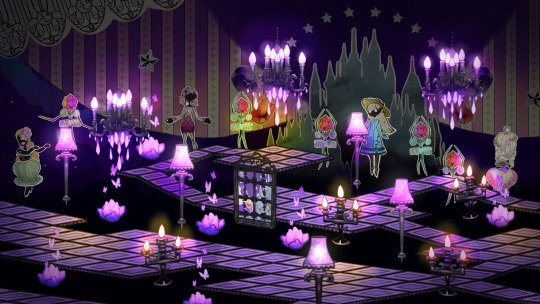
In fact, to talk about any of the other Delusionscapes at this point would be virtually impossible without spoiling crucial story scenes, so suffice it to say we’ve only just scratched the surface here – there are many, many more in this game, each with their own story to tell!
If you could make any delusion into reality, what would your delusion be? Where would it be located, and what effect would it have on your town/city/village/trailer park/biodome? What would the inside of its Delusionscape look like, and what “Grand Phantasm” – representative of the core concept from deep within your soul that spawned this delusion in the first place – would await at the end of it?
We’ve been asking ourselves that very same question here at the XSEED offices, and if you’re lucky, maybe we’ll share a few of our answers with you in a future blog. Because let me tell you, we’re all delusers, baby (though please don’t kill us!).
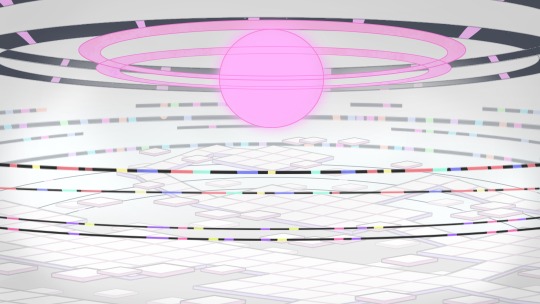
In the meantime, you can join Asahi & co. on their delusion-filled journey May 16th in North America or May 19th in PAL regions, on PS4 or Vita, both versions containing dual voice and dual text (so you can play with any combination you’d like of Japanese or English voice-acting or text). And in fact, although we previously stated that players would have to download the Japanese voices as free DLC for the Vita version, it turns out we were able to include them as part of the base game after all, so all users on both PS4 and Vita will have all voice and text options in all English-speaking regions, right from the start.
Are you ready to be deluded?
Hi, kids!
This is Brittany, Localization Producer at XSEED, editor/graphic text monkey/what-have-you for Trails in the Sky the 3rd, and current head for the Trails series in general. I’m very eager to write this blog, because it’ll be full of updates for FC,SC, and the 3rd.
Let’s get the 3rd’s status out of the way: schedule-wise, we’re currently doing great! When we announced this game last year, I was dead set on getting it out by spring 2017, so I’m very proud to say that goal is being met. Trails in the Sky the 3rd is coming to PC in English on…a date you’ll find out very, very soon.
Barring typos or odd QA hiccups (which can happen when “smashing” PSP and PC code together to get the best of both worlds), the game is in pretty good shape and we’re right where we need to be. It’s cleaning up very well.

| QA is a sexy time and I won’t let you take it away from me.
I’d like to start by properly warning Trails newbies first: please play Trails in the Sky’s first and second chapters before playing the 3rd. Heck, please play them before even reading this blog! Although the 3rd is not a “third chapter” since the Estelle and Liberl’s story wrapped up with SC, this story still relies on knowledge gained by playing those two games. Internally, I’ve said before that the 3rd has only one target audience: people who’ve played both Trails FCandSC. Cold Steelfanswillunderstand some of the lore dumping, but other details will be quite lost on lost you. Though, hey, if you want to purchase it anyway and help support my coffee fund, I ain’t gonna stop you. (Please buy it and play it later. I’m desperate, here.)
I would have loved for this blog to feature more specific details on the 3rd itself, but I tend to consider the series as a whole whenever I do my editing and am constantly referencing/perusing the text from the other games as if they were my current projects. Because of that, I’m going to be noting planned adjustments for the Sky trilogy that I decided were important enough to implement while I was working on the 3rd. We can dig into protagonist and deuteragonist Kevin Graham and Ries Argent in future blogs.
-Dead Emperor Sword > Sword of Abaddon – Loewe’s S-Craft. I meant to fix this during SC’s QA, but there were so many things I was brushing up till the last minute that it was lost in the shuffle. The original is straight-up wrong.
-Pillar of Salt > Salt Pale – You’ll learn more about this in the 3rd.
-Stainrose > Steinrose – This is a classy alcoholic drink briefly mentioned by Schera in Trails FC. This is clearly meant to be Steinrose and was written correctly in SC, so we’re extending that correction to FC.
-Museum Descriptions – Text in the museum in Grancel will either be rewritten or greatly expanded upon in general. These descriptions were shorter due to every editor’s wariness of character limits in games, but that’s not actually a worry here, so woohoo! The Capel will also receive similar tweaks.
-Master/King/Guardian of the Lake – I don’t understand how I missed this one, but boy, did I screw up when doing sweeps. You might remember the Guardian from Cold Steel; it’s a legendary fish. Well, the whole legendary fish thing actually dates back as far as the first game. Turns out, we’ve used a mix of king or master to describe it. I’d considered using the more common of the two in the current text, “master,” but I realized “master” is used in several other forms throughoutFCandSC. To make its intent clear, I’m going the easy route and replacing all instances of king/King/master/Master with “Guardian” like the way it is in Cold Steel I&II.

| Mysterious boy who isn’t so mysterious if you’ve already played Cold Steel. This marks his first Trailsappearance.
- Duke Dunan – I believe that even if he’s Queen Alicia II’s nephew, being a duke, he should be addressed as “Your Grace.” He’s been addressed as a number of things, including “Your Excellency” by Phillip and Kanone, so this will be corrected.
-Sky Bandits – I talked about this a bit with the current series translator, and we decided that the term ‘sky bandits’ wasn’t the name of the Capua family’s group in particular. They’re simply bandits…who happen to do their bandit-ing while piloting a sweet airship. It’s not a term specific to them, but as generic as “thief” or “schoolteacher.” It shall be decapped in all instances throughout the trilogy.
There are a few more words I decided to decap, and no doubt I’ll find even more in the future. They’re minor in comparison, though, so they’re not really worth listing here.
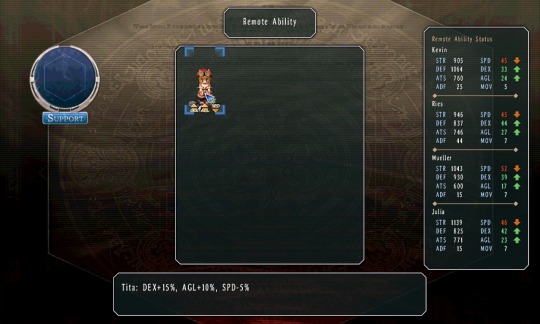
| Here’s a new feature, the “Remote Ability.”
-Airship/Orbalship/Flying Boats – Here’s one that’s bothered me for some time even though I couldn’t figure out a better solution. There’s an entry in the Capel about orbal airships stating that ships less than 20 arge in length are known as “flying boats.” We don’t actually use that term anywhere else, but no one ever brought it up so I left it as is. While reading through the games again, however, I noticed that we used both “airship” and “orbalship” as generic terms.
It’s specifically thanks to orbal energy and the Orbal Revolution that modern civilization in Zemuria was able to achieve flight, so presumably all airships regardless of length use orbal energy. I don’t think it’s a stretch to scientifically classify small ships as “airships,” larger ships which require significant orbal energy as “orbalships,” and have “airships” be used as a generic term among citizens at the same time. After all, we in real life still can’t seem to decide if Pluto is classified as a damn planet or not, even if the population generally seems to refer to it as a planet no matter what its classification is. With this update, I will do away with the clunky and never-used “flying boats” in favor of the current entry.
-Hmm-Hmm!/Hm-Hm!/Etc. – Like Cold Steel I&II, this kind of chortle/laughter isn’t present at all in the 3rd. It was toned down considerably before launch in SC, but it’s still present in both FCandSC. I’ve always wanted to go through the script and alter/remove these, and I finally did! Maybe some will object to this decision, but if they’re not in the newer games, it’s just kinda weird to keep them in the older games, too. In case you wanted to know how much I suffered to do this:
o “hmm-hmm” (164 hits in 96 files)
o “hmmhmm” (184 hits in 85 files)
o “hmhm” (89 hits in 52 files)
o “hm-hm” (8 hits in 8 files)
o “hmm!” (12 hits in 11 files)
o “hm!” (21 hits in 20 files)
o “hmm.” (36 hits in 35 files)
o “hm.” (17 hits in 16 files)
o “Hm,” (62 hits in 41 files)
o “hmm,” (282 hits in 155 files)
-Duke/Baron Fisher – You might recall the president of the Fisherman’s Guild, Mr. Fisher. (Or maybe you do not recall, which suits me better. HEH.) Apparently, his title is mentioned once in both FCandSC—the first time was the “Duke of Angling” and second time was “Baron of Fishing.” This also comes up in the 3rd, but we thought “Fishing Baron” was a simple enough title for the guy, so this will also be fixed in FCandSC.

| From the 3rd’s opening animation.
-Social Sciences/Studies – This is the program Kloe takes at Jenis. I noticed a discrepancy here and there while doing some digging for the name, so all of these have been changed to “social studies.” It’s social sciences in Cold Steel, but since that’s a different country, I don’t consider the difference a big deal.
-Faculty/Staff Office/Lounge – Also noticed this was a number of slightly difference things, so it shall be changed to “faculty lounge.”
-Dorms/Dorm – Unless the person mentioning the dorms at Jenis is referencing both the boys’ and girls’ dorms, I made it singular since there’s only one dorm building each. Not really a problem, but it was bugging me.
-Olivier: “In fact, I believe the Imperial Academy was to launch an investigation…but then the Hundred Days War broke out.” - *nerd glasses* Okay, this one is really cool to me!! I happened to notice the line and was confused by “Imperial Academy, so I checked the Japanese, which was more like “Imperial Science Institute.” Turns out, this is the very same “Imperial Institute of Science” that’s been brought up a few times throughout the Cold Steel arc. (Ahh, I just love how this series connects the little things.)
-Dad/Daddy/Papa/Mom/Mommy/Momma – Estelle as a child calls Cassius “Daddy” in FC, but she says “Papa” in SC.SC will now match FC. Cassius still calls himself “Papa” when babying Estelle, though. I haven’t looked too deeply into this yet, but it’s also been fixed in the following instances so far:
o Anya - Daddy(FC), Papa/Daddy(SC) = Daddy
o Elke - Papa(FC), Papa/Dad(SC) = Dad
o Mirano - Father(FC), Papa/Father(SC) = Father
o Louis - Dad/Mom(FC), Papa/Mama & Dad/Mom (SC) = Dad/Mom
o Helena - Dad/Mom (FC), Papa/Mama (SC) = Dad/Mom
o Lucia - Mommy (FC), Mom/Mommy(SC) = Mommy
I feel ashamed to see all of this…
-Mayor/Lady/Miss/Ms. Maybelle – This one was pretty wild. When checking her address for the 3rd since Lila’s address was translated as “Lady Maybelle,” I went through FC/SC and the results were a mess. Some NPCs referred to her in three different ways, and Estelle went from “Mayor Maybelle” in FC to “Maybelle” in SC. One could argue closeness allowed her to drop the formalities, but I don’t see them as that close. Virtually everyone should be calling her “Mayor Maybelle” now, save for four exceptions: Lila, who calls her “Miss Maybelle, ” and Kloe, General Morgan, and Yahat, who affectionally call her “Maybelle.”
This biggest change affecting all these Sky games, however, will be this:

| You don’t know how happy it makes me to see this.
To refresh your memories, Zin Vathek is an A-rank bracer from the Calvard Republic, and he’s one of the main playable characters throughout the trilogy. However, due to some absurd reason I can’t even begin to understand since I wasn’t with XSEED at the time, the original translation team insisted upon changing his name to Zane.
The series has yet to truly set foot on Calvardian soil, but several characters from there appear to be of Eastern descent. This may lead some to believe that Calvard is mostly an “Asian” country, but personally, I think something very different is going on. Republican names also include stuff like Vathek, Cochrane, or Rocksmith (the Republic’s president). There’s even the Gambler Jack novel that stars a white man named…Jack…and includes characters like Chief Minister Shamrock and Enrique.
I believe Easterners are actually the minority in Calvard, and Eastern influences are reflected in a Chinatown-esque area called the “Eastern Quarter.” Even the writing in Gambler Jack mentions how immigrants tend to gather in the Eastern Quarter, and the writing goes out of its way to point out Eastern features in Halle, the heroine, as if it’s not usual for its author to see.
Throughout the localized games, there have been mentions of people from farther east immigrating into Calvard to the point where it’s become a problem. Incredibly interesting as this is, it’s only been brought up in bits and pieces throughout the series, so I can only make an educated guess on what exactly Calvard is like or what’s going on within. Also, you’ll learn more about this in 3rd and I don’t want to go into detail. These kinds of things could point to racial tension in the future or something else entirely. The more I’ve learned, the more my gut tells me that there’s a reason for these characters—Zin included—to have been given Eastern-influenced names.
While I’ve never been fond of “Zane” to begin with and believe it never should have been changed in the first place, I do understand that it’s been a part of the Trails English canon for many years. Before making the change, I tried to think of various solutions and consulted Falcom’s development team directly with my thoughts. One possible solution was based on many friends who immigrated to the West as children: they had their name from birth, and then they also had a more “white-sounding” name to further blend into Western culture. I thought this method would allow us to keep Zane, finally adopt Zin, and give Zane a few unexpected extra layers.
I’m happy that I expressed these concerns to Falcom’s team, because it gave me the confidence to do away with the more complex solutions and just skip to the overhaul. Moving forward, “Zane” will officially be “Zin” for the entire Trails in the Sky trilogy, and “Zane” will be a thing of the past. I’m excited about this. Please welcome Zin warmly.
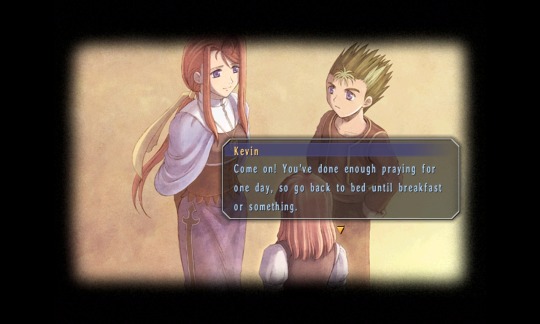
| You’ll see cutscenes like these throughout the game.
In the Future/Other Notes
-Gambler Jack – This novel appears in both Trails in the Sky SCandTrails of Cold Steel II. The CS2 version was brushed up. This may or may not make it into this next update, but I’d like to backport this when I can.
-Skippable S-Crafts – We added this patch into the PC versions of FC/SC in December 2016, but I felt it was worth noting since it’s not in any other version of the Sky trilogy but ours. You can now skip S-Crafts with the press of a button! Yay!
-S-Craft Voices – Years and years ago, before my time, the Trails in the Sky trilogy was all dubbed at once just because it was battle lines and it was easier to get it all finished in one go. Some mistranslations happened here and there in those battle lines. It’s why Kloe shouts, “Radiant Plash!” instead of her actual S-Craft name, for example. The lines from one of Kevin’s S-Crafts gets mentioned as part of 3rd’s story, and you might notice it differs from the text in his actual S-Craft. I’d like to fix the voice someday, but we’ll have to work with the original for now. Just know that it was a conscious decision to not match the story text and battle lines.
-NPC Names – Like Zin, a few NPC names I believe have references that were initially missed. Mirano/Trino/Modena are supposed to be Milan/Turin/Modena, I believe, Stain is supposed to be Stein, etc. These all these like relatively minor in the grand scheme of things and have no real impact on the world-building, though, so I’m still compiling a list and debating if it’s even worth touching this. I still want to…but lol.
NPCs are truly trouble in this series… I have a bible I made myself for the series, but I’d love to keep filling it in!!
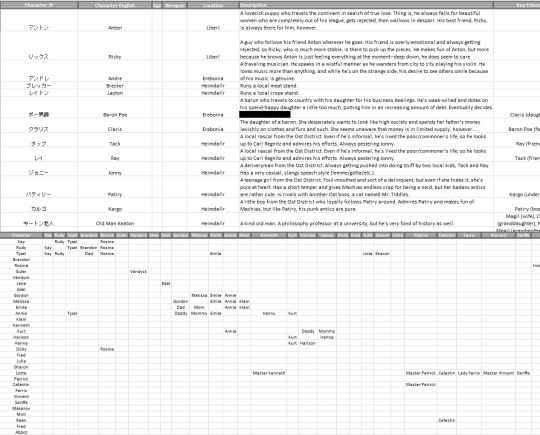
|I’m slowly building stuff like this in the name of obsession.
Ideally, one of the other big changes would be the basic name on Steam/GOG/Humble being displayed. We’ve always gone with Trails in the SkyandTrails in the Sky SC, but I worry names like these as an introductory header may cause confusion among newer fans. I want to someday rename these display names Trails in the Sky First ChapterandTrails in the Sky Second Chapter. We’ll see.
My hope is that outside of Zane > Zin, you guys noticed approximately none of these things and will end up reading this blog and going, “Huh. This person’s obsessed, but okay. Cool.” But how do these things happen? The same way it always happens with text-heavy games: too many cooks in the kitchen. Too many translators, too many editors. Many of these choices are perfectly valid out of world context, but when you’re given thousands of files, no unified index for characters unless you build it from scratch yourself, and some very nasty deadlines, things happen.
The series is much more unified than ever because we realized that when it comes to text-heavy projects, taking our time with a smaller team yields a much better result than throwing as many people as possible at it. CS1,CS2, and the 3rd proved it. In a perfect world, I could go over FCandSC’s text line by line and tweak things in ways fans likely wouldn’t notice just to create further consistency, but considering I do these tweaks in my free time out of pure passion for the series, that’s gonna have to be saved for another day. I’m already very blessed to be given the opportunity to comb through older files and tweak at my leisure. Or maybe I just have a very unusual hobby.
Should you come across any issues that have cropped up unexpectedly with this update (which will be before the 3rd’s launch), please feel free to contact us. Stuff happens, things break, but we’re always willing to look into it and fix it if it’s within our power. My heart belongs to the series forever, so anything I can do if time allows it, I try. Thanks for reading this update, kids, and I hope to write more about the 3rd soon!

| Yes, this actually is in the game.
Hi there! Remember, back in December, when we had an “End-of-the-year Question Extravaganza Blog”? And how there was going to be a second part? Well, FINALLY, here it is! Round two of our answers to the questions that you sent to us via Twitter, so long ago.
Who’s playing this time:
Tom – Localization Producer
Brittany – Localization Producer
Junpei – Assistant Product Manager/XSEED’s Garbage Disposal
Ryan – Localization Lead
Nick – Localization Editor
Alyssa – Product Associate
Liz – QA Tester
Danielle – QA Tester
WARNING: Spoiler alert, just in case! And maybe some language.
Question: which character from Senran Kagura New Wave would you most like to see become playable in a future game
Liz:
There are so many! Kasumi, Kumi, Fuga, and Bashou
Kasumi - shy girl that can code her way into your heart? aw yuss.
Kumi - ngl I like foxes. I’m also hella curious what her animations would look like…
Fuga - dude it’s fireworks coming from a shamisen who doesn’t wanna SEE THAT. AND THOSE PLATFORMS. DAMN.
Bashou - paintbrushes: creation, destruction, or the beauty that comes from their combination? tune in next time on quiet girls that can artfully kill you
Brittany:
Fuga. I’ve loved her design ever since I first saw it and I’ve actually begged Takaki-san in person to put her in one of the core games.
Alyssa:
Picking just one is hard, so these are the ones are the top of my list:
Meimei – She fights by throwing bombs shaped like steam buns. Just. Yes.
Ukyou – For some reason, I really like the idea of a machine gun shaped like a bass guitar. She’s also a cutie, I like her design.
Seimei – I like the fact that she rocks pajamas. I wish I could wear pajamas all the time…

Question: What is your most favorite game that you have localized And why?
Brittany:
Trails of Cold Steel II. I cried so much while working on it, haha. It was the game that made me feel like I was really growing up as a writer, and I was so proud of the effort I put into that during every step of the process. Everyone knows I love the series, but for now, that game has a particularly strong place in my heart because I feel like I grew as a person together with those in Class VII (is this too cheesy? lol).
Junpei:
Definitely the EDF series. I’ve been a big fan of the series since the first EDF came out in Japan, but also I learned a lot from the producer and the dev team. It was a very exciting to work on, and luckily, EDF2: Invaders from Planet Space was selected as a D.I.C.E Award nominee.
Also, Touhou: Scarlet Curiosity was a favorite, too. The game is very fun and pretty. I didn’t really know about the Touhou series at first, but this was a good title for Touhou beginners like me to learn what Touhou is. The dev team is very passionate and professional. I was always impressed by them while working on this.

Ryan:
I have a few personal favorites: Estival Versus because I love the character banter, Deep Crimson for the same reason, and Suikoden V because it was my first real localization project and I still have a soft spot for it.
Alyssa:
I have a soft spot for Ys: Memories of Celceta. It was published before I started working here, but was the first XSEED game that I played.
Even though we didn’t really localize it (just published it physically), I’m a big fan of Shantae: Half-Genie Hero. Working with WayForward was an absolute treat and I’m so glad that we have a chance to do something with them.
Tom:
I think anyone who knows me knows my answer to this, but in case you don’t: RETURN TO POPOLOCROIS, BABY!! ;) The very first game script I ever translated was part of the script to PopoloCrois Story II on the PS1, which I translated in play-script format and uploaded to GameFAQs as a translation guide. After that, the very next thing I translated was all 51 episodes of the two existing PopoloCrois anime. I am a PopoloCrois super-fan, and when the opportunity came along to work on a PopoloCrois game, to say I was ecstatic would be an understatement. Getting to officially write English dialogue for Prince Pietro Pakapuka, Narcia the forest witch, the White Knight, and the GamiGami Devil was an absolutely amazing experience, and getting to sit in on voiceover sessions and help shape the way they sounded in English was the icing on the cake.
Corpse Party is a close second, though, because I was able to get much more graphic than I’m used to, and it was a bizarre amount of fun describing some of the most horrible acts of mutilation and torture imaginable. It was weird working on Corpse Party and Fishing Resort at the same time, as I had to keep stopping myself from inserting extremely graphic language into the Fishing Resort script.
And Akiba’s Trip: Undead & Undressed gets an honorable mention, as the three weeks spent in voice-recording for that game may be the most fun I’ve had in my seven years at XSEED.
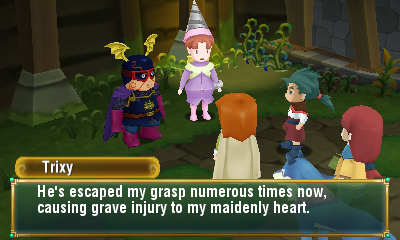
Question: Where do you face the most unexpected challenges during the localization process?
Nick:
The thing about unexpected challenges is that they’re…well, unexpected. The things we run into the most frequently are things we know to be watchful for based on past experience (which is why we usually catch the major stuff). A good example of an “unexpected challenge” would be realizing partway in that we don’t actually have all the text files for the game, even though the developer said they gave us everything. Working on games that are still in production also has the tendency to turn up a lot of unexpected issues, particularly when the developers change things and neglect to mention that they were changed. If you learn that a localization was being worked on while a game was still in development, know that it was probably a huge headache for the translators and editors compared to working on something that has been finished and more or less finalized.
Sometimes it’s because there’s an honest mix-up and they thought they’d given us everything. Other times there’s a breakdown in communication along the way, as can occur when information has to pass through too many hands. So…ultimately, miscommunication is where we stand to face the most unexpected challenges. It varies from project to project, and we know to be mindful of it, but we can never fully predict when this sort of issue will pop up.

Question: Where do you try to draw the line between remaining loyal to the original and changing to fit the region you are localizing for?
Nick:
Every editor will give you a different answer for this, so I can only speak personally, but here’s where I stand on this issue. When I localize a game, I absolutely want the intent of the original to come through. That’s what people are coming to the work for - what they want to experience. However, sometimes, truly conveying the spirit of the original work necessitates departing from the exact language of the original.
If one facet of my job is about accurately conveying information and character relationships, another facet is to ensure people who buy our games are entertained and engaged. That happens best with a script that feels fairly natural in its English phrasing. A quick example is how, if you listen to people converse, most people make frequent use of contractions. They’re a natural linguistic shorthand for English, so it feels natural to make broad use of them in character dialogue. But I often see dialogue written without them (like, where it doesn’t strike me as an intentional editorial choice). Without contractions, at the most basic level, you’ll get dialogue that sounds wooden and has less flow to it (Tom and I often compare it to the speaking style of Data, from Star Trek: TNG), but in some cases, using or not using contractions can subtly alter the way we perceive a line, especially if there’s no voice-over to clue us in. “I cannot believe he said that about me” carries a bit more of a testy tone than “I can’t believe he said that about me.”
There are also cultural differences that, when translated over on a 1:1 basis, won’t elicit the same response from an international audience, so some tweaking is necessary to make sure Western players of a game experience enjoyment similar to what Japanese players would’ve felt. This is admittedly a touchy issue, since a lot of this involves getting a good feel for the characters’ personalities, and so is inevitably colored by an editor’s own interpretations of them. In a blog I wrote before the first Trails of Cold Steel was released, I laid out some cases where I basically felt that the characterizations provided in some places by the original script were lacking, so Kris and I embarked on a mission to strengthen characterization not through any sweeping gestures, but just by bringing certain traits more clearly to the fore in scenes specific characters were in. It’s something you might notice if you had the Japanese and English scripts side by side, but it never stood out to most players, and from anecdotal accounts I’ve read many places online, I think this initiative of ours was very successful. Certainly, I think it brought a lot to Rean’s character in particular.
Ultimately, I want a localization to keep all the information the original script gave, but sometimes I re-frame how that information is conveyed because I value entertaining/engaging writing and want our games to feel, as much as possible, like the English scripts could just as well have been the original scripts.
“So, where do I draw the line? As someone who always wants to push for better writing, I generally won’t make an edit - even if it would sound great - that would result in dropping factual information conveyed by the original. Not necessarily on a line-by-line basis, but definitely on a scene-by-scene basis. Ultimately, I want a localization to keep all the information the original script gave, but sometimes I re-frame how that information is conveyed because I value entertaining/engaging writing and want our games to feel, as much as possible, like the English scripts could just as well have been the original scripts.”
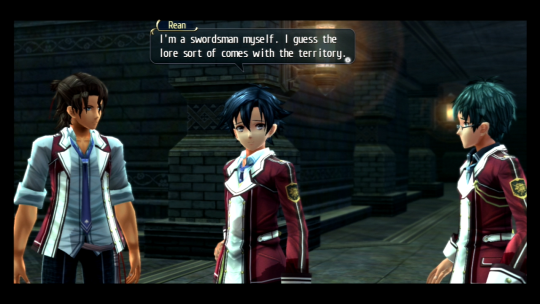
Brittany:
This question is too broad and no one should have one answer for it. It depends on the game itself, the context, the importance of the topic in question in the scope of the story, the emotional impact it’s supposed to make. The most generic answer I can give is that we should always remain loyal to the spirit/intent of the original game, and if anything comes under question, we should consult the dev team and get their perspective on it.
I guess an example that’s happened a few times throughout Trails is one where Japanese honorifics are dropped as people become closer. A big deal is made out of it, but that sort of thing doesn’t exist in English. At the same time, there’s no reason to force it in the English version because the name-dropping isn’t necessarily the focus–it’s the result of characters becoming closer. The intent is the bond, and as long as you write the scene so that English players understand these characters have become closer thanks to what’s going on, then I believe we’re still loyal to the Japanese while still properly localizing the scene.
Question: outside of trails in the sky sc what was the hardest game to work on you’ve released?
Brittany:
It’s a toss-up between Unchained Blades and Rune Factory 4. RF4 was a joy to work on because I’m a big fan of the series, but it also contains so many complex algorithms that even the Japanese version of the game occasionally had random bugs that just couldn’t be reproduced. Those were everywhere during QA, and then we also had had all that text that needed to be checked for context…
Unchained Blades is far shorter with less text, but it was plagued with bugs during QA to the point where I once ran to the bathroom to cry from losing my save data for the umpteenth time. We had no debug mode for that one, either, so anything I had to test, it had to be done by playing through like a normal player. Hopefully the effort was worth it. I don’t think I’ve ever heard of players experiencing the issues on that game that I had!

Ryan:
Probably Fate/EXTELLA, which had a lengthy, lore-heavy script with a long history behind it, plus a writing style that was both abstractly poetic and strictly technical.
Danielle:
I would say the Story of Seasons series, mostly because of the sheer volume of text and variables to test.
Question: which sort of cultural references do you try to keep rather than rewriting for localization?
Tom:
Generally, all of them. It’s always better to keep a reference, and just maybe insert a brief explanation, than to get rid of it. People who play our games know that they’re playing Japanese games, so I figure, why try to disguise the Japaneseness of them? Better to celebrate it.
Ryan:
Depends on the medium and context. Fate, in general, is known in part for drawing lore from all over the world, so we did our best to keep its references to world history and literature intact. Akiba’s Trip was chock full of Japanese-language anime references, some of which had only unofficial translations, so we did our best to cobble together appropriate translations from Japanese and English fan sites. SENRAN KAGURA drops references to well-known anime now and again, well-known enough that we can keep them intact, with an English take on their wordplay (such as when Katsuragi’s play on “a great era of sexual harassment,” referring to the “great era of piracy” from One Piece, became “a great invasion of privacy.”) Occasionally, we’ll run across Japanese proverbs that don’t have direct translations, so we’ll do our best to find English proverbs or wordplay that match the general sentiment of the original.

Question: What was the situation in a game that gave you trouble? Joke? A conversation? Interactions? Items? Names? Tell us the worse!
Tom:
Shiawase no Sachiko, in Corpse Party. To this day, I’m still not 100% satisfied with my translation there.
See, in the Japanese, there’s supposed to be a distinction between 幸せのサチコ (“Shiawase no Sachiko”), which roughly translates to “Happy Sachiko,” and 死合わせのサチコ (a different way of writing “Shiawase no Sachiko”), which roughly translates to “Sachiko Aligned with Death.”
The English I came up with for this is “Sachiko Ever After” vs. “Sachiko in the Everafter.” And even that vaguely acceptable solution took far, FAR too long to come up with.
Sometimes, Japanese linguistic references are just really tough to work with!
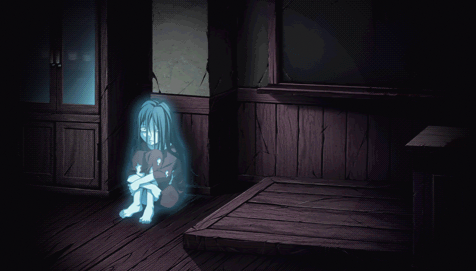
Ryan:
The first example that comes to mind is a certain “My Room” conversation from Fate/EXTELLA, where Nero and the Master have a back-and-forth conversation about different kinds of bathing. The original Japanese script had an entire conversation tree about misreadings of kanji, which had no direct translation. This is one of those rare times where we were tempted to, as we sometimes call it, “Go full Samurai Pizza Cats,” after the old anime dub where the American dub team never received the original script and had to make up a whole new one, but we stuck with it, and eventually came up with some reasonably close wordplay in English.
Question: Do you have friends in other localization teams/companies? What could you learn from them? Do you reach out to them?
Brittany:
I’d love to hang out with some of the localization people I’ve interacted with via Twitter, because I’m actually pretty ignorant of what goes on in other companies. I’m pretty much XSEED only, but I’d love to learn the process in other places or just bond with others who do the same work that I do.
Tom:
Absolutely! Other companies are “competition” to an extent, but they’re also colleagues, and we’ve met with people from numerous other nearby companies for lunch, karaoke, etc. many times since I’ve been working here at XSEED. I don’t know that we really learn much from them, nor they from us, but we always “talk shop” when we meet up, discussing localization challenges we’ve faced, fun stuff we’ve done recently, etc. It’s just good to sometimes talk with other people who fully understand what we do.
Ryan:
We’re good friends with the Aksys team down the street, a lot of our staff have Atlus experience, and most of the original senior staff came from Square-Enix. For Fate/EXTELLA, the Aksys guys were kind enough to share their notes and script from Fate/EXTRA as references. One of the best bits of advice I can give people looking for work in the industry is “Make friends wherever you go,” and that’s as true once you’re in as it is when you’re getting started.
The Way of the Waifu
By Ryan Graff, with contributions from Brittany, Tom, Mai, Liz, Junpei, Billy, Jason, Ken, Alyssa, and Nathan
XSEED was quite a change of pace and style from my last job, which was working QA for the usually T-rated Square-Enix. A few weeks before my first day here, Ken and Jess sent me some reference materials for my first XSEED project, wrapping up the European version of Valhalla Knights 3. I remember reading through the game’s text files, reading descriptions for items called “Survibrator” and “Congratulotion,” and wondering exactly what I’d signed on for.
It wasn’t long after VK3went gold that I started my second major project here, co-localizing the main script for SENRAN KAGURA Shinovi Versus. Since I hadn’t played Burstbefore coming to the office, I took a crash course, reading up on the characters’ histories, relationships, and personalities.

SENRAN KAGURA has always gone out of its way to make each of its many characters as distinctive as possible in every way. Each girl has her own personality, visual style, fighting style, vocabulary, and personal history, and their stories grow and develop from game to game.
It’s not always easy for storytellers to juggle ensemble casts. Audiences need time, screen time, to bond with your characters, and it can be tough to balance the audience’s attention and affection amongst a large cast while also keeping the story moving forward. But when a storyteller pulls it off, the payoff is that each audience member, no matter who they are, gets at least one favorite character, someone they can personally relate to and root for.
With that in mind, one of the most frequently asked questions about SENRAN KAGURA is, “Who’s your favorite?” Since we write for the English version of the game, that question sometimes comes in different flavors, like “Who do you enjoy writing for the most?” or “Who would you most want to hang out with?” In short, which girl is XSEED’s waifu?
Me personally, I like writing for Haruka most, because I enjoy writing “eloquent, haughty young lady”-type characters (writing for Nero in Fate/EXTELLAwas fun for the same reason), and because she’s so crafty and unpredictable. In terms of who I’d most want to hang out with, I think Mirai would make a fun writing buddy, Homura would make a kickass personal trainer, Shiki reminds me of my first crush, and Murasaki could always use a hug.

(We also occasionally get asked who our least favorite character is, but I like them all too much to really say, other than to note that I hope Minori gets more onscreen character development in future titles.)
But I’m not the only one who works on SENRAN KAGURA — credit goes out to everyone who proofs, tests, helps market, and otherwise contributes to the games (especially by playing them at home and spreading the good word!) — so let’s go around the office and see who’s down with who:
Brittany:
Haruka. She’s a true queen and I’d thank her if she stepped on me.

Billy:
I would say my SK waifu is Asuka. She is the first character I used. I also like her fighting style and her clumsy personality. But Rin is cool too.

Tom:
Hard to pick only one, but I’d have to go with Hikage, whose struggle with emotionality makes her extremely endearing, but is more than made up for with awesome moves and general kickassness. Honorable mentions go to Mirai for the amazing outfit, Ayame for having the cutest face in the series (seriously, how is she so cute?!), and Imu for her admirable devotion to the one she loves (which makes her less viable as “waifu” material, but more awesome as a character IMHO).

Liz:
Hikage, all day.
- has no emotions
- is sometimes a berserk snake
-licks uses knives
- chill af
I was into masochistic gun ballerina for a while but she too hyphy.
Mai:
Naraku ❤
- super loyal
- love the way she call herself (I believe it’s “I” in English but in Japanese, she calls herself “Jibun” instead of “watashi”)
- fashionista (her hoodie and arm warmer thing)
- bubble gum❤
- not so emotional

Junpei:
My SK waifu is Yozakura.
- She speaks the Okayama dialect, which sounds super cute when girls speak it.
- She has giant fists.
- She’s good at cooking.
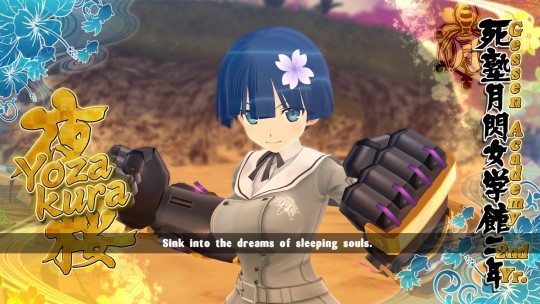
Jason:
I’m a nice guy and like all girls (except Minori and Hibari). But my top 3 would be Homura, Kagura, and Renka.
Homura: She’s Wolverine and voiced by Eri Kitamura.
Kagura: She’s god and fights by ripping holes in dimensions.
Renka: She drums like no other.

Ken:
Homura. Tan lines. ‘Nuff said.

Alyssa:
Rin definitely stole my heart (I’ll fight you for her, Billy!). Purple hair and glasses? Sign me up! But I also love her weapon and fighting style, as well as her friendship with Daidoji. ❤
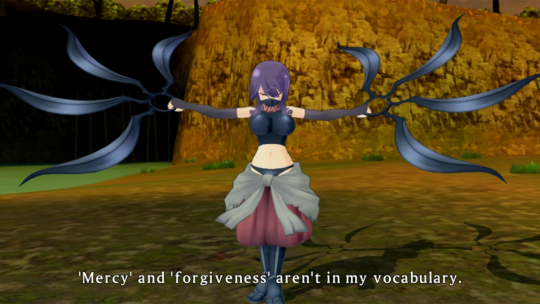
Nathan:
Shiki. Something to be said about a multilingual witch.

As I wrap this up, SENRAN KAGURA Estival Versus has just gone up on Steam, and the Ikki Tousen DLC characters are finally available on PS4, Vita, and PC, after a long struggle to bring them overseas. (Thanks again, Takaki-san!) We hope everyone enjoys reconnecting with the girls (or meeting them, if it’s your first time), and keep your eye out — you never know what might come next!
Howdy, everybody! This is John with our final localization blog for Story of Seasons: Trio of Towns. The game comes out next Tuesday (2/28). Don’t miss out on your chance to preorder the game from select retailers to get the adorable capybara pocket plushie bonus, which I have had a lot of fun posing for our little “Capy and Bunny Adventures” comics over the past month. (Okay, sometimes it was a little embarrassing getting those photos.)
We just released a new trailer showing off the four Super Mario Bros. costumes that you can unlock in the game. We’ll also be streaming the game on our Twitch channel from 2:30 PM PST today. Stop by and ask us some questions.
Before I bury the lede any further, I’d like to update you all on the DLC for Story of Seasons: Trio of Towns. For more information on the patches released for free over the course of six months after launch in Japan, as well as our dilemma about whether or not to localize this content, see my previous blog.
We were really overwhelmed by the feedback we received from it. The patience and support of those who responded was encouraging to say the least, and we were grateful to hear all of your opinions, however you felt about the situation. One issue that came up on our forums that I’d like to address quickly is about the bug fixes that were included in the post-launch patches in Japan. Those fixes are all already included in the core game that we are releasing on February 28.
Now then, on to the big news: I’m happy to report that we have decided to localize and release the DLC in North America. I don’t have information on a release timeline or costs for you yet, but we’re eager to dive into translating and editing the text for this massive update. Stay tuned for updates in the months after the initial release.
Thanks again for all your feedback. It made our decision much easier. While the DLC is a ways off, until then we hope you enjoy Story of Seasons: Trio of Towns. Even without the post-launch DLC, it is still the biggest game in the storied history of the farm/life-sim series.
As this is our final planned pre-release localization blog, I wanted to give some of the other members of the XSEED staff who worked on Story of Seasons: Trio of Towns a chance to give their comments on the game. As I mentioned in our very first blog, this game had a massive amount of text that we spent months and months focusing on.
Here are our questionnaire respondents:
Danielle: QA tester and editor
Nathan: QA tester
John: Project lead
1. Who were your favorite character(s) to work on and why? Have any lines in particular made an impression on you?
John: It’s hard to choose, but I will say that I love the dynamics between all the Lulukoko characters. Some of my favorite text in the game are the conversations that will take place between 3-4 characters during certain festivals. The normal groups (Zahau-Caolila, Lotus-Mithra, Iluka-Siluka-Ludus) are great, but funny conversations happen when you mix those characters together. There’s a really great exchange between Lotus and Tototara.
2. What were your favorite changes and/or additions made to the game?
Danielle: Streamlined farming. Unlike in the previous game, harvested animal by-products and crops go straight into your inventory.Another feature I really like is the addition of actual dog/cat breeds. The previous game had about 4 different “breeds,” and were mostly reskins. SoS: ToT has about 16 unique different breeds of dogs, and I have no idea how cat breeds work, but trust me when I say there’s a lot more variety there. And last but not least, there’s the new–and adorable–capybara!
3. Which of the three towns do you like the most, and why?
Danielle: Lulukoko hands down for me. I absolutely love locations with tropical and/or oceanside settings. The music for Lulukoko is one of my favorites in the game as well.
Nathan: Lulukoko. Generally speaking it had my favorite bunch of characters, shop hours that matched my playstyle, and the most expensive stuff on the ground for scavenging.
John: Tsuyukusa has my favorite music and some really beautiful scenery. The homes and shops are jam-packed with interesting decorations and knick-knacks from Japanese culture. All of those cultural references were difficult to localize, but I think they make the town so interesting for players.

Many of the decorations in Tsuyukusa are explained by the characters in dialogue.
4. Favorite bachelor/bachelorette? (Minor spoiler about a secret marriage candidate)
Danielle: Ludus. (Ford is pretty great too, though.)
Nathan: For the bachelors, I like Ludus, as he’s a good dude that works hard and helps directly. As for the bachelorettes, it’s a toss up between Siluka and Inari, though I may be biased as I spent a good deal of time with Siluka. Meanwhile, Inari is a god, so…
John: It’s a little weird seeing Inari referred to as a “bachelorette,” as we tried to keep the Tsuyukusa guardian’s text as gender-neutral as possible. (Though, ultimately, Inari will call him or herself your “husband” or “wife” in some scenes depending on your character’s gender. This is accurate to the Japanese text.)
Anyway, here in the office, Ludus is sort of everyone’s favorite because he’s so attractive and kind-hearted, but for me Ford is the funniest and sweetest bachelor. His response if you dump him just about broke my heart.
Iluka is a treasure. Komari was my choice when I originally played through the game in Japanese, and she’s definitely more my “type.” But Iluka’s sass just turned out so well in English.

To be fair to Iluka, most characters ask you to come back later if you talk to them while they’re eating.
5. Do you have a favorite non-farming SoS activity?
Danielle: Decorating my farmland (or house) is always fun. I also really enjoy creating all the different outfits.
Nathan: Mining for sure, GIVE ME ALL OF THE MONEY.
John: I love fishing in these games. There are so many different fish in Trio of Towns too; it seems like it could almost be its own game. Also, you no longer have to mash the A Button to reel your line in, which is gentler on my hands and my 3DS.
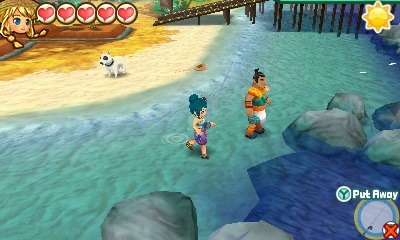
Fish alongside Lulukoko’s master angler, Zahau.
6. Which aspect of the game do you tend to focus on? The social or the farming?
Danielle: I’d say I probably focus about 60% on the social and 40% on the farming.
Nathan: I tend to do an equal amount of both, as I try to set up my farm to require as little attention as possible (and by that I mean planting trees). I do enjoy taking care of the animals though, especially my prize-winning cow: Horse.
John: I’m usually more interested in the social side. I’m always impressed by players who really micromanage their farms. (Like Nathan, who quickly became a fruit tree tycoon during his QA playthrough.)
7. Which festival would you most like to participate in IRL?
Danielle: The Beverage Bash. I like cooking (making drinks counts as cooking, right?), and I love tea even more, so getting together with a bunch of people to try and create a new drink concoction sounds like a ton of fun. I just hope people in real life have more common sense than to bring mayonnaise as an ingredient.
Nathan: Westown’s Goddess Festival, because, let’s be real here for a second, there’s a giant pizza. Giant. Pizza.
John: The “stargazing” events in Westown and Lulukoko are nice. In Westown, you go up in a hot air balloon to look at the stars. In Lulukoko, you go out in a boat to admire bioluminescent “sea sparkles” in the ocean. (Tsuyukusa has a similar event based on the Japanese festival Tanabata.) The prospect of going up in a hot air balloon (Westown) without a trained pilot is less appealing the more I think about it, however.

The “Beverage Bash” event.
8. If you were a character in Trio of Towns, what would be your number one most loved and hated item?
Danielle:
Loved: Pumpkin Pie
Hated: Pickles
Nathan:
Loved: Black Coffee
Hated: Mushrooms, of any type
John: There are over 1,100 items in this game, so it was hard to decide.
Loved: Curry (all types)
Hated: Olive (Who even likes these?)
You would also lose friendship points with me if you shoved a cat in my face (allergies).
9. What features or changes would you like to see implemented in future games?
Danielle: The biggest feature I’d like to see the return of is the multi-floored mining system (as seen in some of the Wii-era games), as opposed to just the mining points.
Nathan: I’d love to see something along the lines of expeditions or fishing trips for rare fauna as pets, plants, or fish.
John: I would like the developers to bring back larger wilderness areas and even caves/mines to explore. That was the thing I missed most in Trio of Towns.
And, of course, it would be nice to finally have same-sex dating options.
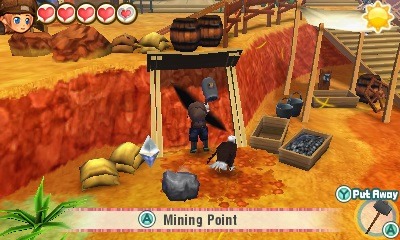
Don’t swing too far back, now.
That’s all from us. We really hope you enjoy the game. Look for another entry starting with “Howdy, everybody” on this blog in a few months’ time.
Howdy, everybody! For the past week, we’ve been posting self-introductions written by the eligible bachelors in Story of Seasons: Trio of Towns on the game’s Facebook page. We’ve collected them all here, so get to know them before meeting them in the game when it releases on February 28.
We also have a brand new trailer introducing these handsome hunks.
Wayne

Howdy there, darlin’! You must be the new farmer I’ve been hearin’ so much about.
I’m Wayne, Westown’s postman. It’s a pleasure to meet ya. Welcome to the frontier! If ya ever get homesick, drop on by our post office and send off a letter to your folks.
I came here from the city, myself. When I applied to be a postman and they sent me out here to the sticks, at first I was nervous about the country life. But I have to say I love it out here. The people are friendly, the food is fresh, the air is clean…yessir, country living is the way for me. I hope ya like it as much as I do.
You can find me wanderin’ all over the three towns on my rounds from early in the morning. I couldn’t survive without coffee. After gettin’ home all I want to do is unwind with a bath and a good book.
Ford’s my best friend, though I’m sure he’ll deny it. He’s always givin’ me medical advice, and in return I try and coach him up on how to talk to women. Most of my advice is on the level, but I’d be lyin’ if I said I didn’t throw him a curveball every once in a while to see if he’ll actually do it. C’mon, don’t look at me like that!
Let me know if ya need anythin’ at all. Don’t be a stranger now, y’hear?

Ford

Good afternoon. Are you here for a checkup?
No? Then may I inquire as to the purpose of your visit?
You would like me to introduce myself?
…Just where do you think we are right now? This is no social club and I am no young man about town. This is a clinic and I am the attending physician. You may call me Dr. Ford while in the confines of these walls during regular business hours. Simply Ford will suffice when I am off-duty.
Furthermore, do I detect traces of dust on your clothes? Are those spots of mud on your shoes? Must I repeat myself? This is a medical facility. When you present yourself in my clinic, you will be clean, groomed, and properly attired. I understand that you are a farmer, but that is no excuse for poor hygiene. There are no fields for you to till in here. I will not have you putting my other patients at risk with your lackadaisical approach toward personal care.
…
Excuse me. I might have gotten a bit worked up just then. I take my work very seriously, and I suppose I am guilty of holding others to the same high standards I set for myself. Wayne has repeatedly told me I must relax, and I believe he is right.
Let me try again. Please call me Ford. If you ever have need of a doctor, my door is always open, day or night. I hope we can be good friends.

Hinata

Thin sticks, thick bricks. Thin sticks, thick bricks.
Six sticky skeletons.
She sells sea shells by the seashore.
Black back bat. Black back bat. Black back bat.
…
Hmm? What am I doing? I’m reciting tongue twisters to practice clear pronunciation. You could hear me? Shoot, I’ve gotta stop mutterin’ to myself.
Anyway, I’m Hinata! I work the general goods counter at Mr. Moriya’s wholesale store. Nice to meetcha!
I’ve been workin’ for Mr. Moriya since I was 13. I have loads of brothers and sisters, so I left home and came to Tsuyukusa to live on my own and earn my keep. I miss my family, but we still trade letters and stuff. And I really like workin’ for Mr. Moriya.
Huh? What about the tongue twisters? They’re useful for makin’ sales pitches, but they’re really for what I do when I get off work. I’m in an actor’s troupe in another town! Got bit by the acting bug when I watched a play with Yuzuki and his grandma Omiyo. I’m still workin’ my way up the ranks though. Gotta keep chasing my dreams, you know?
If you like, come and see me perform sometime. And it goes without saying that you’re always welcome to say hello at Mr. Moriya’s shop. Just…make sure to buy something every once in a while, okay?
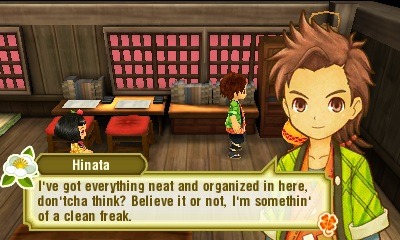
Yuzuki
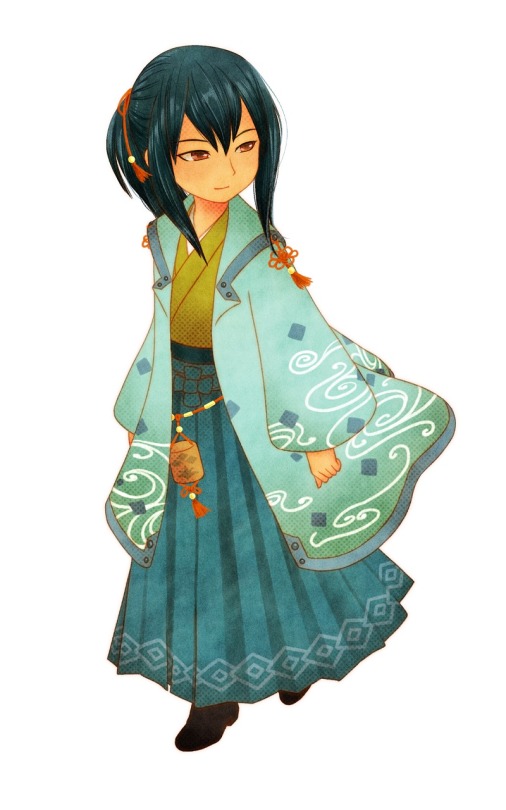
Hello there. You must be the new farmer from the old property by the crossroads. My name is Yuzuki. It’s a pleasure to make your acqua—
!!
Forgive the imposition, but could I ask you to hold still for just a moment? The light is striking your hair in such a way that… Yes, I see it now. That would be a lovely color. But what to do about the material? And of course it shouldn’t be too—
Oh, excuse me. That was a terribly rude way to treat a new acquaintance. Please accept my apologies. You see, I design accessories by trade and have been in something of a creative rut of late. When I saw your hair, I was struck with inspiration for a new design.
As I was saying, my name is Yuzuki and I live here in South Tsuyukusa with my grandparents, Omiyo and Umekichi. You can often find me in my workshop here on their farm. Please stop by to visit any time.
If I’m not in, then you will likely find me strolling about Tsuyukusa. Nothing helps spark my imagination like a brisk walk. Not to mention that Ginjiro’s restaurant is on my usual route, and I do love tea and a nice dessert after a stroll.
There are many people around our age here in Tsuyukusa. I hope you can become good friends with all of us. I promise not to treat you as a model again…at least, not without your permission, of course.
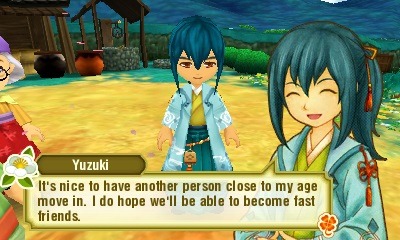
Ludus
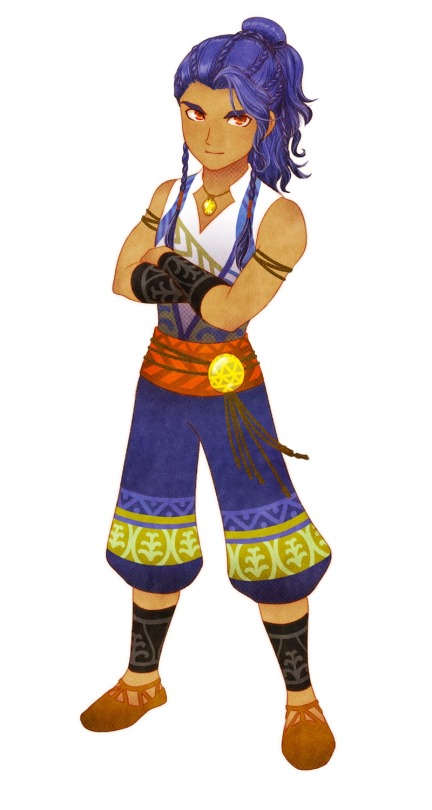
Aloha. You’re the new farmer, yeah? I heard about you from my grandmother. Welcome to Lulukoko Village. I’m Ludus.
People around here call me “handyman” or “jack of all trades” because I offer all sorts of services at my shop, Relacion. Whether you need a home renovation, a tool upgrade, or even some clothes tailored, I take almost all requests.
Have you met the twins, Iluka and Siluka? I built their café. The wind and waves are always battering away at the supports, so upkeep is a full-time job, yeah? But those girls are like sisters to me, so I can’t say I mind helping them out. We all grew up together, after all.
Just…don’t let them tease you too much, okay? Siluka isn’t so bad, but Iluka? She’s a little…okay, she’s a LOT convinced that she’s queen of the world. Sometimes I wish I had a nice “sister,” you know?
Like everyone here in Lulukoko, I love the sea. Work sometimes takes me to Westown or Tsuyukusa, but I have to say I prefer the air here. The smell of sand and salt just mean “home” to me. I often go fishing in my time off. Whenever I catch a big one, I’ll take it to the kitchen in the twins’ cafe and fillet it.
It’s awesome that you’re running a farm on your own. If you ever need anything at all, don’t hesitate to ask. I’m always happy to lend a hand.

Howdy, everybody! For the past week, we’ve been posting self-introductions written by the bachelorettes in Story of Seasons: Trio of Towns on the game’s Facebook page. We’ve collected them all into a blog post.
We also have a brand new trailer introducing these lovely ladies.
Lisette

Howdy! You must be new around here. Call me Lisette! I’m pleased to meetcha.
I run the flower shop in Westown. I took it over from my parents a few years ago after gettin’ a degree in horticulture in the city. I just love it here in town; everyone is so sweet and helpful. Carrie and Miranda are like big sisters, and Wayne and Ford are a hoot.
What kinda things do I like? Gosh… Well, I like flowers. Duh, right? Nothing makes me happier than makin’ an original bouquet for a customer.
An’ what’s more, fresh flowers don’t just brighten up a room, they have special meanings. Even the same type of flower can have different meanings dependin’ on what shade it takes, so I’m always careful about how I compose a bouquet. Wouldn’t want someone else fluent in flowers gettin’ the wrong idea from a present, you know? The language of flowers even covers fruits and vegetables. For example, the apple flower represents…
Oh, gosh! I’m sorry for ramblin’ on like that.
I also love reading. What kind of books? Umm… I definitely like books that adults should be reading! Not storybooks or anything childish!
My dislikes? Well… I’m perfectly fine with most bugs since I work with plants all day, but there’s somethin’ about snails. The same kinda goes for food too—I can’t stomach anythin’ slimy.
Anyway, come by my shop sometime if you need flower seeds. Don’t be a stranger!
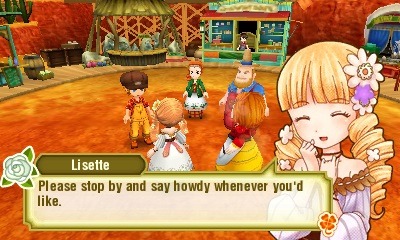
Kasumi

Greetings. It is a pleasure to make your acquaintance. My name is Kasumi.
…
…
Excuse me. I am not much for “small talk.”
Introduce myself? Very well.
I teach basic learning, such as reading and writing, to children at a nearby schoolhouse. However, my place of birth is far from Tsuyukusa. My father is a scholar, and I received a classical education from a governess. This included ancient literature and poetry—of which I am fond—as well as painting and martial arts.
I am not…accustomed to holding conversations with the opposite sex. I much prefer female company or even solitude, and I typically spend my time off working on my calligraphy or practicing with the naginata and the bow. These activities encourage reflection, mindfulness, and self-discipline. Talking with men encourages nothing of the sort.
I do not much care for sweets and will usually pass any I receive along to Komari or Yuzuki, who are more than happy to oblige me by receiving them. Other than desserts, I enjoy many of Tsuyukusa’s traditional dishes. I rather enjoy living here, even though I am separated from my mother and father. It is a peaceful town full of friendly people.
Now, if you will excuse me, I must be going.
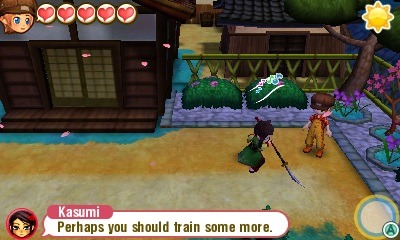
Komari
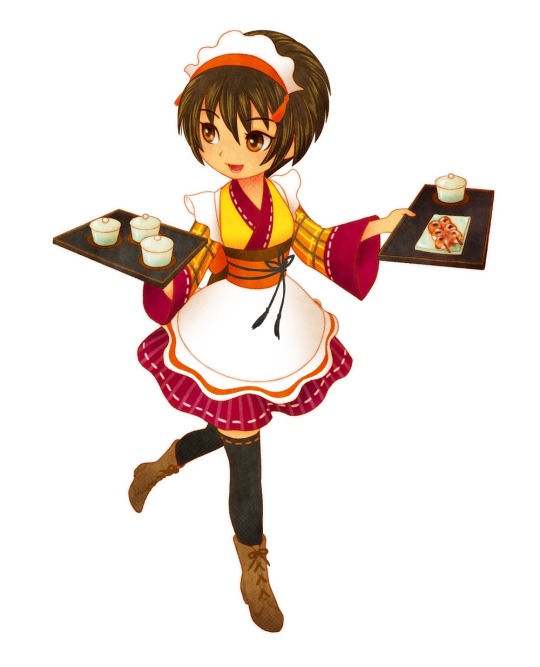
Hiya, nice to meetcha! The name’s Komari!
My dad and I run the teahouse in Tsuyukusa. We’re real proud of it! Dad works the counter and cooks all the food, an’ I take it out to the customers. My mom is off travelin’ the world, so it’s just the two of us holdin’ down the fort.
I like waitressin’, but Dad says I’m too casual with the customers. Sometimes I wish I could be more like Shizu, who runs the clothing counter at the wholesale store and is this totally refined lady. I’ve been thinkin’ I should ask her for lessons or somethin’. I got no time to go to finishin’ school.
Speakin’ of which, sometimes I get the feelin’ I spend TOO much time workin’, y’know? Ever since I was little, almost all my free time has been eaten up helpin’ at the shop. I really, reeeally wanna find some kind of hobby that I can tinker around with. Nothin’s jumped out at me yet though.
There aren’t many things I hate. I’m not a fussy person. Almost wish I was, though. Then I could say I have “taste”! Haha! But I really like most Tsuyukusa dishes. Guess that comes from growin’ up in THE Tsuyukusa teahouse, huh?
Anyway, be sure to say hi when you stop by the teahouse, ‘kay? See ya!
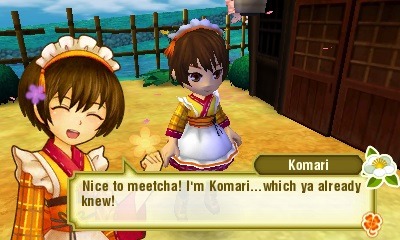
Iluka

Komo mai! Welcome to Lulukoko’s famous seaside café, Carosello. We have lots of fruit drinks, chilled teas, and desserts that will help you beat the tropical heat.
So…what can I get for you today?
…
Well, are you a customer or not?
…
You’re just here to say hello?
*SIGH* Don’t make me waste all my customer service positive aura on you. You’re the new face, right? I’m Iluka, the owner of this café. See the girl in blue, the one who looks EXACTLY like me? That’s Siluka. We’re the famous and enchanting tw–
Siluka! Stop spacing out and take table 2’s order!
Like I was saying, we’re the famous and enchanting twin priestesses here in Lulukoko. We keep the village traditions as passed down by Gram. Oh, right. I’m talking about Ludus’ grandmother, Tototara. Come see us dance in front of the flames at the New Year’s Festival. We’re breathtaking! We also have special powers, so DON’T cross us or we’ll hex you, got it?
I make the drinks here, and tea is my specialty. Siluka does the heavy cooking, though. Not that I can’t cook! I can! She’s just more experienced.
The two of us grew up with Ludus. He can be a bit of a coconuts-for-brains, but I guess he’s handy to have around sometimes. He DID build us this café. He and Siluka are so quiet though. Sometimes when we’re all together I end up doing all the talking.
Here come a few more customers. If you’re not going to buy something, you’re just taking up space. Aloha!

Siluka

Zzz…
Zzzzzz…
Hmm? E kala mai. I must have dozed off.
Iluka’s always scolding me for napping on the job. Her eyes get big and her aura turns dark red and…oh, never mind. It’s nothing worth getting worked up over.
Oh, I’ve never seen your aura before. It’s very pretty. Are you new here?
I’m Siluka. My twin sister Iluka and I run the seaside café here in Lulukoko. We’re also the village priestesses. Iluka talks tough and likes to threaten people with curses, but please don’t take her too seriously. We ALMOST never have to jinx anybody.
Haha. That’s just a little joke. We do have special abilities, though, like predicting the weather and seeing auras.
Everything has an aura. Did you know that? Most people can’t see them, but they reflect the interconnectedness of all living things. Those who are connected to the natural world have the prettiest hues. So I can tell that you work with plants and animals just by the color you glow.
I find nature very…soothing, and my favorite things are the simple bounties of the earth and sun. I love all types of fruit. I am also interested in medicinal herbs. Ludus’ grandmother Tototara has passed down recipes for traditional medicines to me. They’re my greatest pride and a treasured secret…
…
…
Hmm? Oh, I was just looking at that sunny spot and thought I’d take a short rest. Goodbye for now.
Zzz…
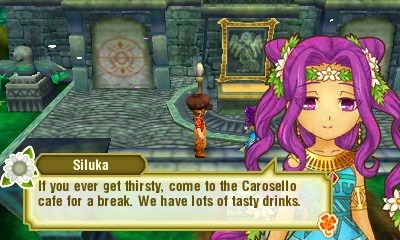
This is John again with an update about the Story of Seasons: Trio of TownsDLC.
The short version is, we haven’t decided whether or not to localize it yet, and if we do, we’ll have to charge for it. Read on for more details.
If it isn’t obvious already, we love Story of Seasons fans and pay attention to your feedback. In addition to our Facebook and Twitter pages, I check other outlets to see what players are talking about. So I wanted to give you an honest update about the DLC situation and see what you have to say about it.
The long version is as follows:
To my knowledge, Trio of Towns is the first game in the long-running series to include post-launch DLC.
The DLC, released for free in four patches over six months in Japan, includes the following:
- A new bachelor and bachelorette: Stephanie the contest MC and Woofio. Yes, Woofio the contest judge in the dog suit. This includes new resident and romance events for these characters
- A few new events such as your father coming to visit and getting together with friends of the same gender for a meal
- The ability to have a child with the game’s secret marriage candidate
- A new “performer” story (Which are similar to the TV channels in the previous Story of Seasons)
- A new pet, Cheburashka, a Russian cartoon character that has a presence in Japan
- New costumes, including ones based on Lest and Frey from Rune Factory 4
- New reaction dialogue for different outfits and pets from bachelors and bachelorettes
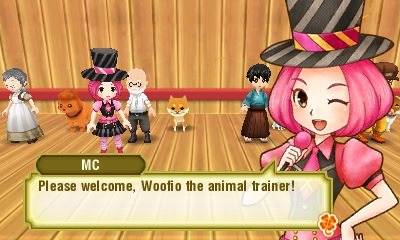
One of the DLC patches unlocks Stephanie as a Westown resident and marriage candidate. Not to mention she finally has a name.
The total size of the DLC is over 200,000 Japanese characters, making it as large as some games we’ve released. The first Corpse Party, for example, has about 210,000 characters.
The last round of DLC was released in Japan in mid-December, which means that the Japanese text was completed after we’d entered the QA and submission phase of localizing the main game. With DLC of this size, including it in the game would have been impossible under our schedule. It would have forced us to release months after we’d originally planned.

The Performer is a traveling showman who will read one chapter from a story per day. The illustrations are by “guest” artists.
So, will the DLC ever be released in North America? The truth is that we’re still discussing it. Given the size of the DLC, it would cost upwards of six figures to localize it (over half of which is programming and QA costs). For the amount of money and manpower we would need, we could almost release a full other title. The price of the base game in Japan is more than in North America, and they sell about twice as many games as we do here, factors which made it easier for them to release the DLC for free. We are really grateful to fans for their continuing support of the series under its new name, but releasing DLC of this size for free is beyond our means.
This places us squarely between a rock and a hard place. We either don’t localize the DLC at all, or we release it as paid DLC. Neither of these is ideal, but we have to be realistic as a smaller publisher.
The price point we’re looking at, after comparison with other paid DLC with similar content, is $3.99 each for three patches. (Patch 1 and 2 from the Japanese version, which contain less content than 3 and 4, would be combined.) Making for an even more bitter pill is that by charging for the DLC, we would be unable to include Cheburashka (and even offering him for free wouldn’t have guaranteed the license extended out to North America indefinitely). The above details aren’t set in stone, but it is the most likely plan if we do localize the DLC.
In my last blog, I wrote that it kills us to release a game without all the content of the original version. Dealing with this situation has been even harder than removing Hamtaro from the game, as I know that some of you are looking forward to wooing Stephanie or Woofio, or having a child with the secret marriage candidate. We want to work on the DLC. (Though, I don’t know if the person tasked with editing over 500 lines of Woofio dog puns will feel the same.)
Even though there’s no best-case scenario here, we’ve chosen to lay all of this out and see what you all have to say about it. We take your comments seriously, so let us know what you think.

One DLC patch adds Woofio as a marriage candidate. All joking aside, he actually has an interesting backstory.















